Psychological Effects of a Stoma/ostomy on a Individual’s
VerifiedAdded on 2022/08/21
|21
|6450
|12
AI Summary
Contribute Materials
Your contribution can guide someone’s learning journey. Share your
documents today.
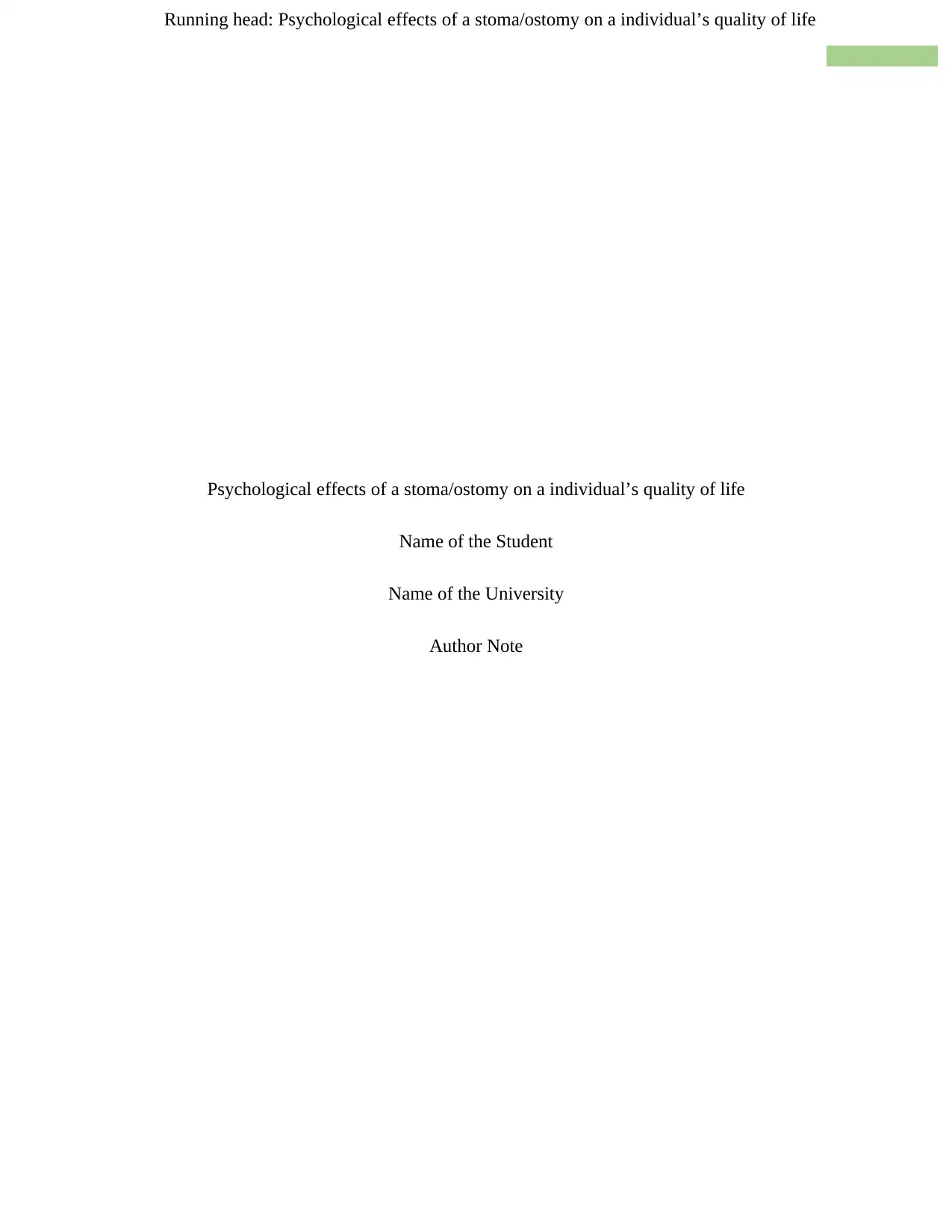
Running head: Psychological effects of a stoma/ostomy on a individual’s quality of life
Psychological effects of a stoma/ostomy on a individual’s quality of life
Name of the Student
Name of the University
Author Note
Psychological effects of a stoma/ostomy on a individual’s quality of life
Name of the Student
Name of the University
Author Note
Secure Best Marks with AI Grader
Need help grading? Try our AI Grader for instant feedback on your assignments.
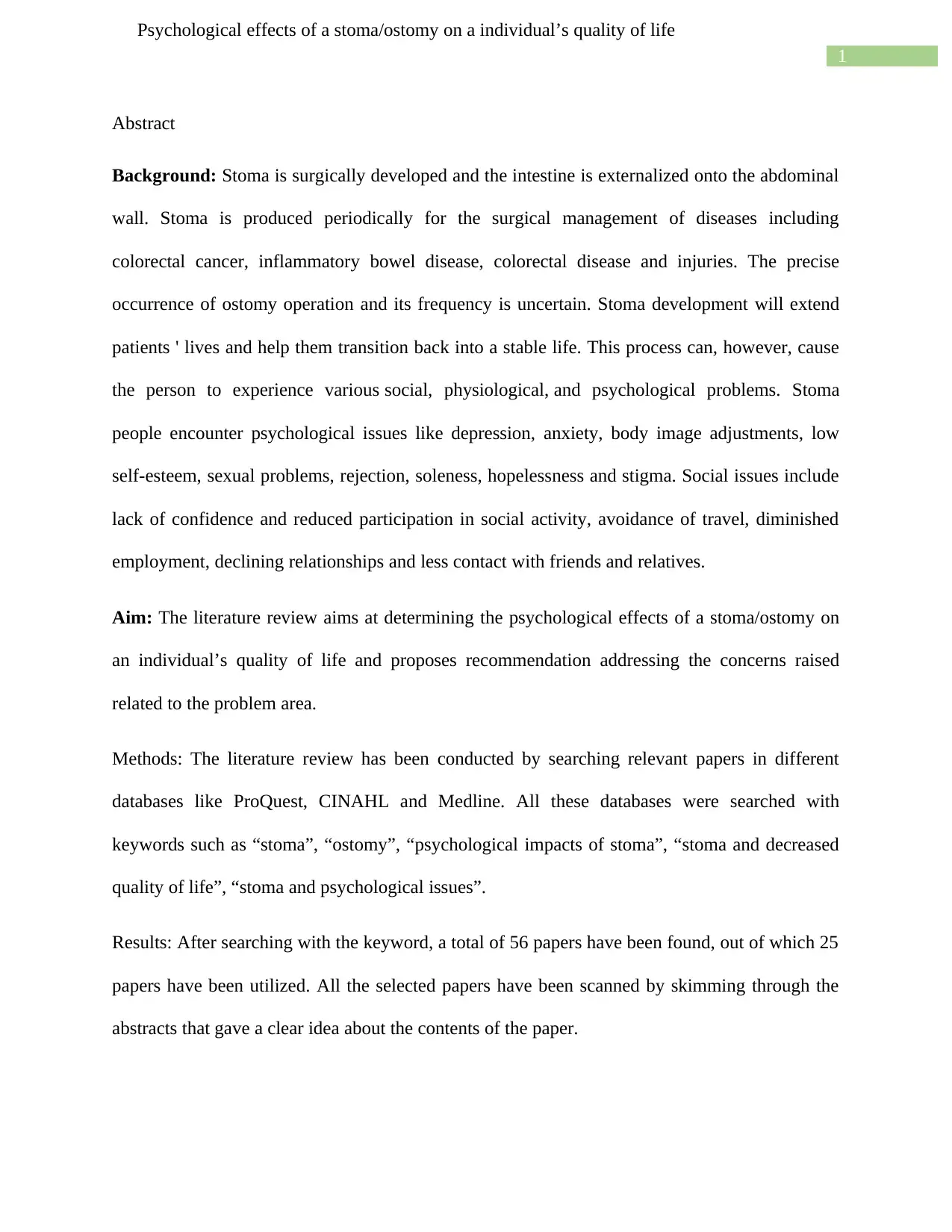
1
Psychological effects of a stoma/ostomy on a individual’s quality of life
Abstract
Background: Stoma is surgically developed and the intestine is externalized onto the abdominal
wall. Stoma is produced periodically for the surgical management of diseases including
colorectal cancer, inflammatory bowel disease, colorectal disease and injuries. The precise
occurrence of ostomy operation and its frequency is uncertain. Stoma development will extend
patients ' lives and help them transition back into a stable life. This process can, however, cause
the person to experience various social, physiological, and psychological problems. Stoma
people encounter psychological issues like depression, anxiety, body image adjustments, low
self-esteem, sexual problems, rejection, soleness, hopelessness and stigma. Social issues include
lack of confidence and reduced participation in social activity, avoidance of travel, diminished
employment, declining relationships and less contact with friends and relatives.
Aim: The literature review aims at determining the psychological effects of a stoma/ostomy on
an individual’s quality of life and proposes recommendation addressing the concerns raised
related to the problem area.
Methods: The literature review has been conducted by searching relevant papers in different
databases like ProQuest, CINAHL and Medline. All these databases were searched with
keywords such as “stoma”, “ostomy”, “psychological impacts of stoma”, “stoma and decreased
quality of life”, “stoma and psychological issues”.
Results: After searching with the keyword, a total of 56 papers have been found, out of which 25
papers have been utilized. All the selected papers have been scanned by skimming through the
abstracts that gave a clear idea about the contents of the paper.
Psychological effects of a stoma/ostomy on a individual’s quality of life
Abstract
Background: Stoma is surgically developed and the intestine is externalized onto the abdominal
wall. Stoma is produced periodically for the surgical management of diseases including
colorectal cancer, inflammatory bowel disease, colorectal disease and injuries. The precise
occurrence of ostomy operation and its frequency is uncertain. Stoma development will extend
patients ' lives and help them transition back into a stable life. This process can, however, cause
the person to experience various social, physiological, and psychological problems. Stoma
people encounter psychological issues like depression, anxiety, body image adjustments, low
self-esteem, sexual problems, rejection, soleness, hopelessness and stigma. Social issues include
lack of confidence and reduced participation in social activity, avoidance of travel, diminished
employment, declining relationships and less contact with friends and relatives.
Aim: The literature review aims at determining the psychological effects of a stoma/ostomy on
an individual’s quality of life and proposes recommendation addressing the concerns raised
related to the problem area.
Methods: The literature review has been conducted by searching relevant papers in different
databases like ProQuest, CINAHL and Medline. All these databases were searched with
keywords such as “stoma”, “ostomy”, “psychological impacts of stoma”, “stoma and decreased
quality of life”, “stoma and psychological issues”.
Results: After searching with the keyword, a total of 56 papers have been found, out of which 25
papers have been utilized. All the selected papers have been scanned by skimming through the
abstracts that gave a clear idea about the contents of the paper.
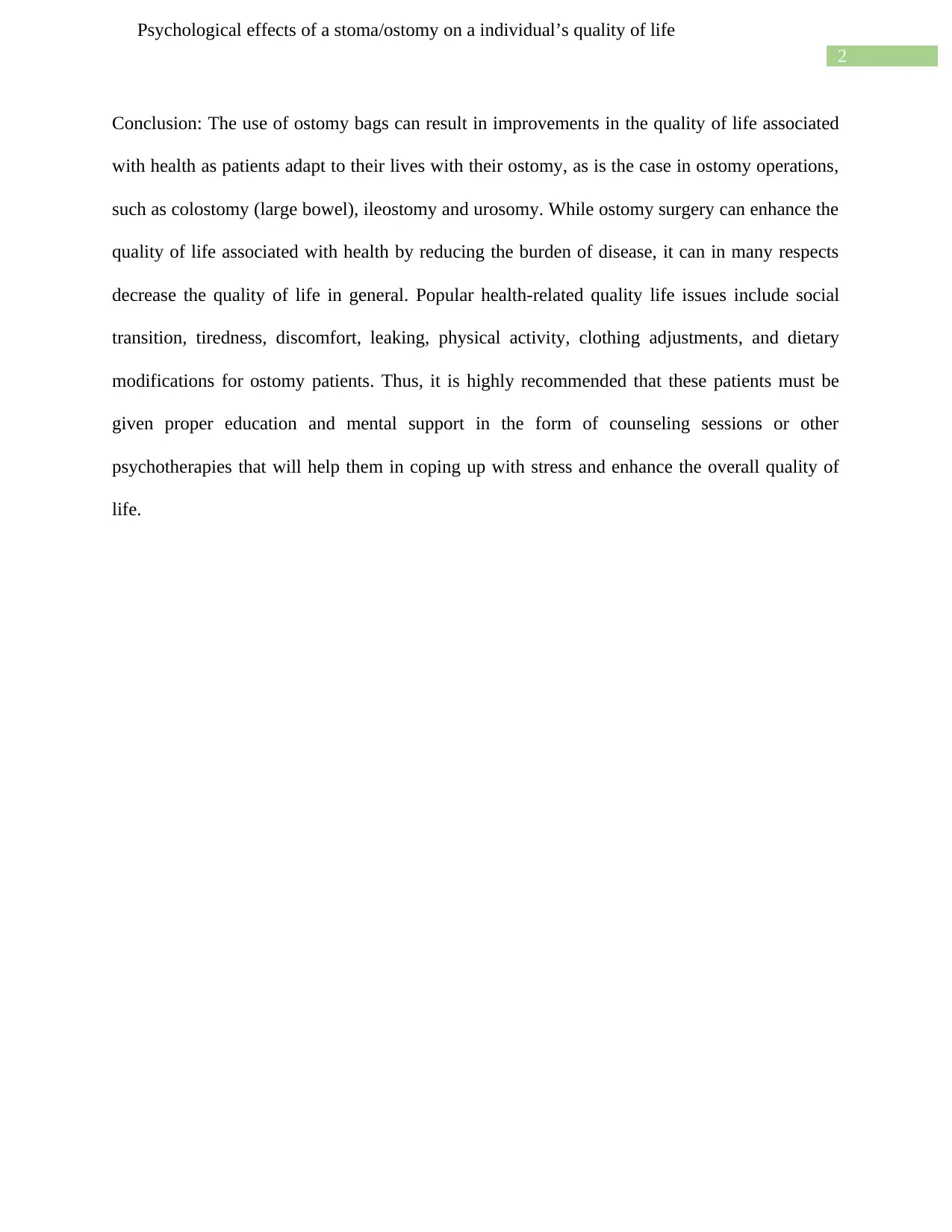
2
Psychological effects of a stoma/ostomy on a individual’s quality of life
Conclusion: The use of ostomy bags can result in improvements in the quality of life associated
with health as patients adapt to their lives with their ostomy, as is the case in ostomy operations,
such as colostomy (large bowel), ileostomy and urosomy. While ostomy surgery can enhance the
quality of life associated with health by reducing the burden of disease, it can in many respects
decrease the quality of life in general. Popular health-related quality life issues include social
transition, tiredness, discomfort, leaking, physical activity, clothing adjustments, and dietary
modifications for ostomy patients. Thus, it is highly recommended that these patients must be
given proper education and mental support in the form of counseling sessions or other
psychotherapies that will help them in coping up with stress and enhance the overall quality of
life.
Psychological effects of a stoma/ostomy on a individual’s quality of life
Conclusion: The use of ostomy bags can result in improvements in the quality of life associated
with health as patients adapt to their lives with their ostomy, as is the case in ostomy operations,
such as colostomy (large bowel), ileostomy and urosomy. While ostomy surgery can enhance the
quality of life associated with health by reducing the burden of disease, it can in many respects
decrease the quality of life in general. Popular health-related quality life issues include social
transition, tiredness, discomfort, leaking, physical activity, clothing adjustments, and dietary
modifications for ostomy patients. Thus, it is highly recommended that these patients must be
given proper education and mental support in the form of counseling sessions or other
psychotherapies that will help them in coping up with stress and enhance the overall quality of
life.
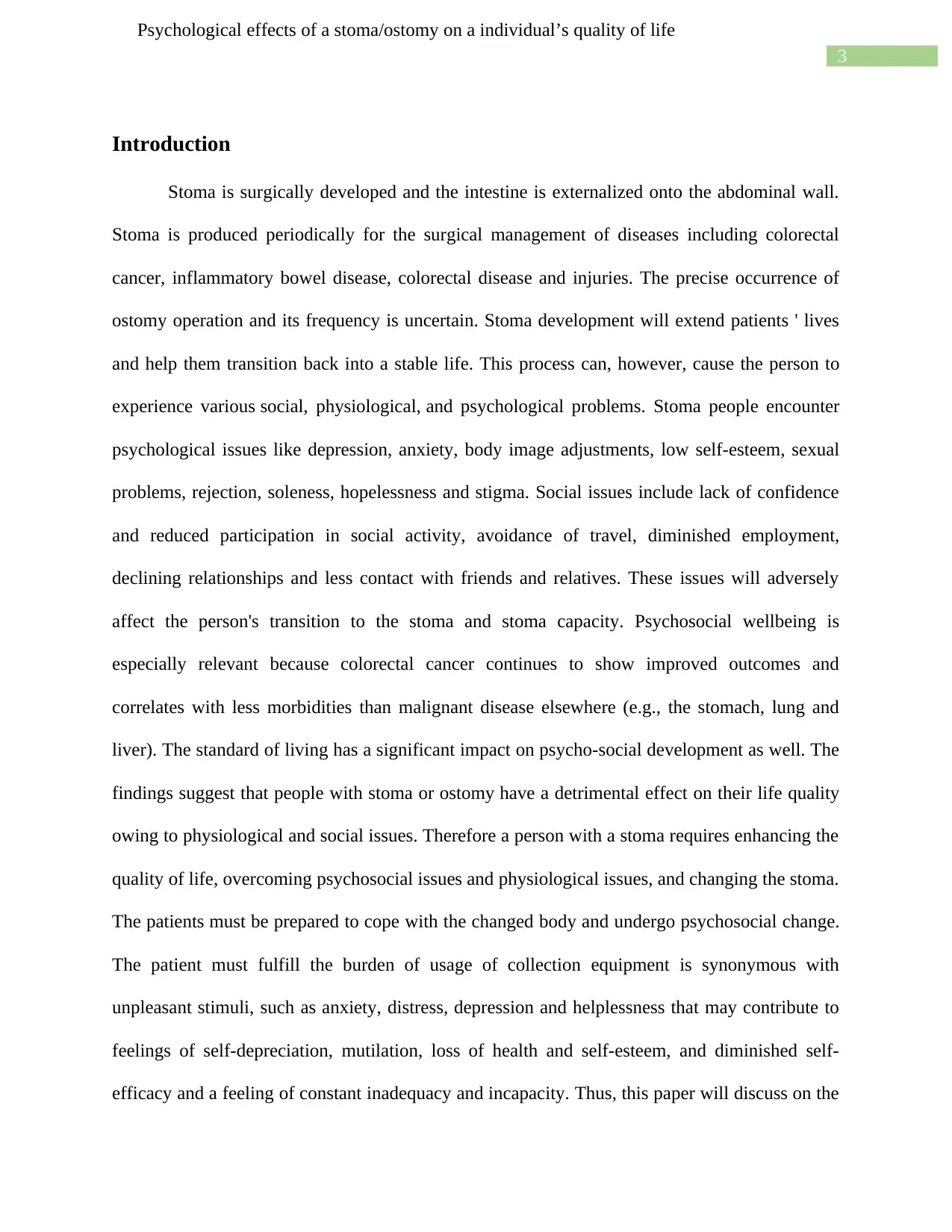
3
Psychological effects of a stoma/ostomy on a individual’s quality of life
Introduction
Stoma is surgically developed and the intestine is externalized onto the abdominal wall.
Stoma is produced periodically for the surgical management of diseases including colorectal
cancer, inflammatory bowel disease, colorectal disease and injuries. The precise occurrence of
ostomy operation and its frequency is uncertain. Stoma development will extend patients ' lives
and help them transition back into a stable life. This process can, however, cause the person to
experience various social, physiological, and psychological problems. Stoma people encounter
psychological issues like depression, anxiety, body image adjustments, low self-esteem, sexual
problems, rejection, soleness, hopelessness and stigma. Social issues include lack of confidence
and reduced participation in social activity, avoidance of travel, diminished employment,
declining relationships and less contact with friends and relatives. These issues will adversely
affect the person's transition to the stoma and stoma capacity. Psychosocial wellbeing is
especially relevant because colorectal cancer continues to show improved outcomes and
correlates with less morbidities than malignant disease elsewhere (e.g., the stomach, lung and
liver). The standard of living has a significant impact on psycho-social development as well. The
findings suggest that people with stoma or ostomy have a detrimental effect on their life quality
owing to physiological and social issues. Therefore a person with a stoma requires enhancing the
quality of life, overcoming psychosocial issues and physiological issues, and changing the stoma.
The patients must be prepared to cope with the changed body and undergo psychosocial change.
The patient must fulfill the burden of usage of collection equipment is synonymous with
unpleasant stimuli, such as anxiety, distress, depression and helplessness that may contribute to
feelings of self-depreciation, mutilation, loss of health and self-esteem, and diminished self-
efficacy and a feeling of constant inadequacy and incapacity. Thus, this paper will discuss on the
Psychological effects of a stoma/ostomy on a individual’s quality of life
Introduction
Stoma is surgically developed and the intestine is externalized onto the abdominal wall.
Stoma is produced periodically for the surgical management of diseases including colorectal
cancer, inflammatory bowel disease, colorectal disease and injuries. The precise occurrence of
ostomy operation and its frequency is uncertain. Stoma development will extend patients ' lives
and help them transition back into a stable life. This process can, however, cause the person to
experience various social, physiological, and psychological problems. Stoma people encounter
psychological issues like depression, anxiety, body image adjustments, low self-esteem, sexual
problems, rejection, soleness, hopelessness and stigma. Social issues include lack of confidence
and reduced participation in social activity, avoidance of travel, diminished employment,
declining relationships and less contact with friends and relatives. These issues will adversely
affect the person's transition to the stoma and stoma capacity. Psychosocial wellbeing is
especially relevant because colorectal cancer continues to show improved outcomes and
correlates with less morbidities than malignant disease elsewhere (e.g., the stomach, lung and
liver). The standard of living has a significant impact on psycho-social development as well. The
findings suggest that people with stoma or ostomy have a detrimental effect on their life quality
owing to physiological and social issues. Therefore a person with a stoma requires enhancing the
quality of life, overcoming psychosocial issues and physiological issues, and changing the stoma.
The patients must be prepared to cope with the changed body and undergo psychosocial change.
The patient must fulfill the burden of usage of collection equipment is synonymous with
unpleasant stimuli, such as anxiety, distress, depression and helplessness that may contribute to
feelings of self-depreciation, mutilation, loss of health and self-esteem, and diminished self-
efficacy and a feeling of constant inadequacy and incapacity. Thus, this paper will discuss on the
Secure Best Marks with AI Grader
Need help grading? Try our AI Grader for instant feedback on your assignments.
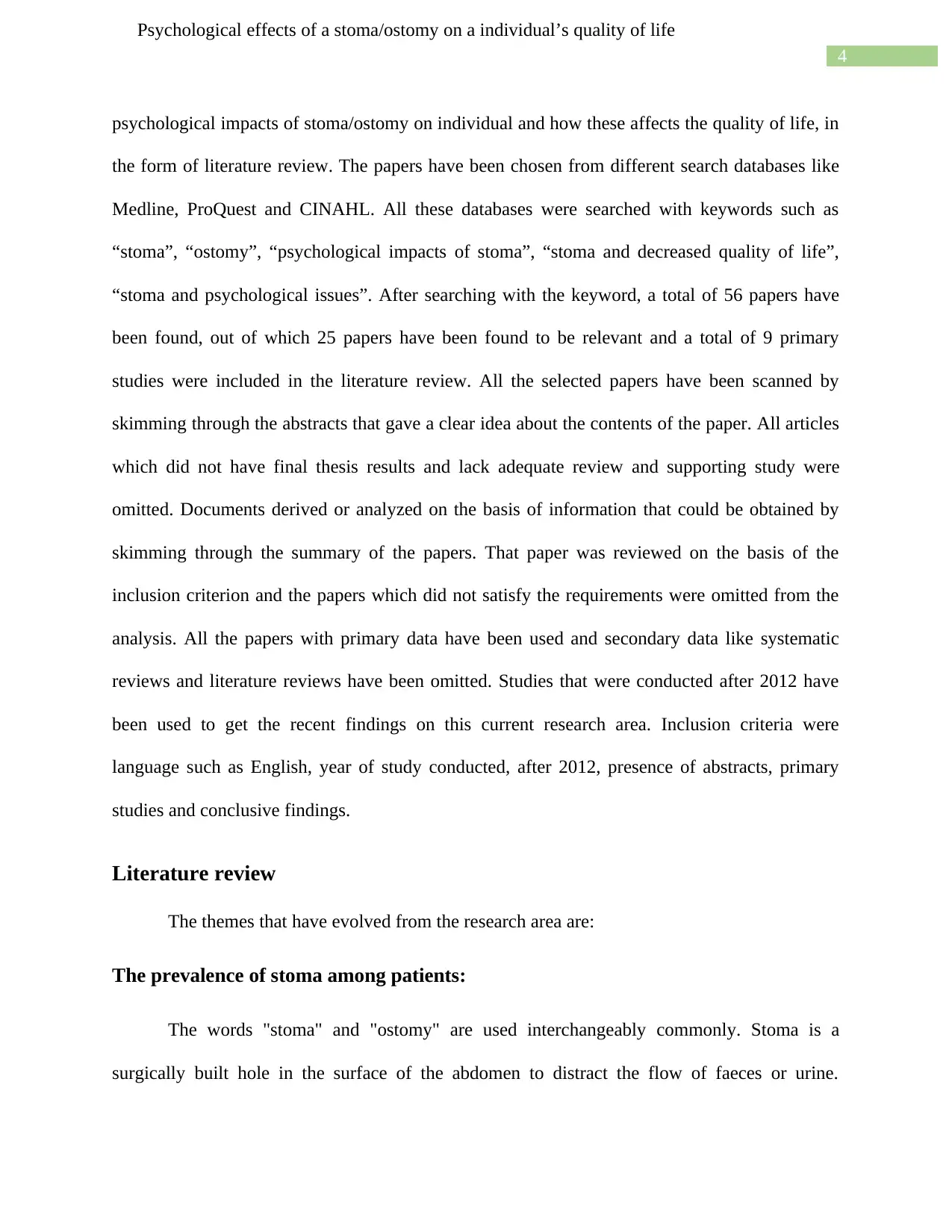
4
Psychological effects of a stoma/ostomy on a individual’s quality of life
psychological impacts of stoma/ostomy on individual and how these affects the quality of life, in
the form of literature review. The papers have been chosen from different search databases like
Medline, ProQuest and CINAHL. All these databases were searched with keywords such as
“stoma”, “ostomy”, “psychological impacts of stoma”, “stoma and decreased quality of life”,
“stoma and psychological issues”. After searching with the keyword, a total of 56 papers have
been found, out of which 25 papers have been found to be relevant and a total of 9 primary
studies were included in the literature review. All the selected papers have been scanned by
skimming through the abstracts that gave a clear idea about the contents of the paper. All articles
which did not have final thesis results and lack adequate review and supporting study were
omitted. Documents derived or analyzed on the basis of information that could be obtained by
skimming through the summary of the papers. That paper was reviewed on the basis of the
inclusion criterion and the papers which did not satisfy the requirements were omitted from the
analysis. All the papers with primary data have been used and secondary data like systematic
reviews and literature reviews have been omitted. Studies that were conducted after 2012 have
been used to get the recent findings on this current research area. Inclusion criteria were
language such as English, year of study conducted, after 2012, presence of abstracts, primary
studies and conclusive findings.
Literature review
The themes that have evolved from the research area are:
The prevalence of stoma among patients:
The words "stoma" and "ostomy" are used interchangeably commonly. Stoma is a
surgically built hole in the surface of the abdomen to distract the flow of faeces or urine.
Psychological effects of a stoma/ostomy on a individual’s quality of life
psychological impacts of stoma/ostomy on individual and how these affects the quality of life, in
the form of literature review. The papers have been chosen from different search databases like
Medline, ProQuest and CINAHL. All these databases were searched with keywords such as
“stoma”, “ostomy”, “psychological impacts of stoma”, “stoma and decreased quality of life”,
“stoma and psychological issues”. After searching with the keyword, a total of 56 papers have
been found, out of which 25 papers have been found to be relevant and a total of 9 primary
studies were included in the literature review. All the selected papers have been scanned by
skimming through the abstracts that gave a clear idea about the contents of the paper. All articles
which did not have final thesis results and lack adequate review and supporting study were
omitted. Documents derived or analyzed on the basis of information that could be obtained by
skimming through the summary of the papers. That paper was reviewed on the basis of the
inclusion criterion and the papers which did not satisfy the requirements were omitted from the
analysis. All the papers with primary data have been used and secondary data like systematic
reviews and literature reviews have been omitted. Studies that were conducted after 2012 have
been used to get the recent findings on this current research area. Inclusion criteria were
language such as English, year of study conducted, after 2012, presence of abstracts, primary
studies and conclusive findings.
Literature review
The themes that have evolved from the research area are:
The prevalence of stoma among patients:
The words "stoma" and "ostomy" are used interchangeably commonly. Stoma is a
surgically built hole in the surface of the abdomen to distract the flow of faeces or urine.
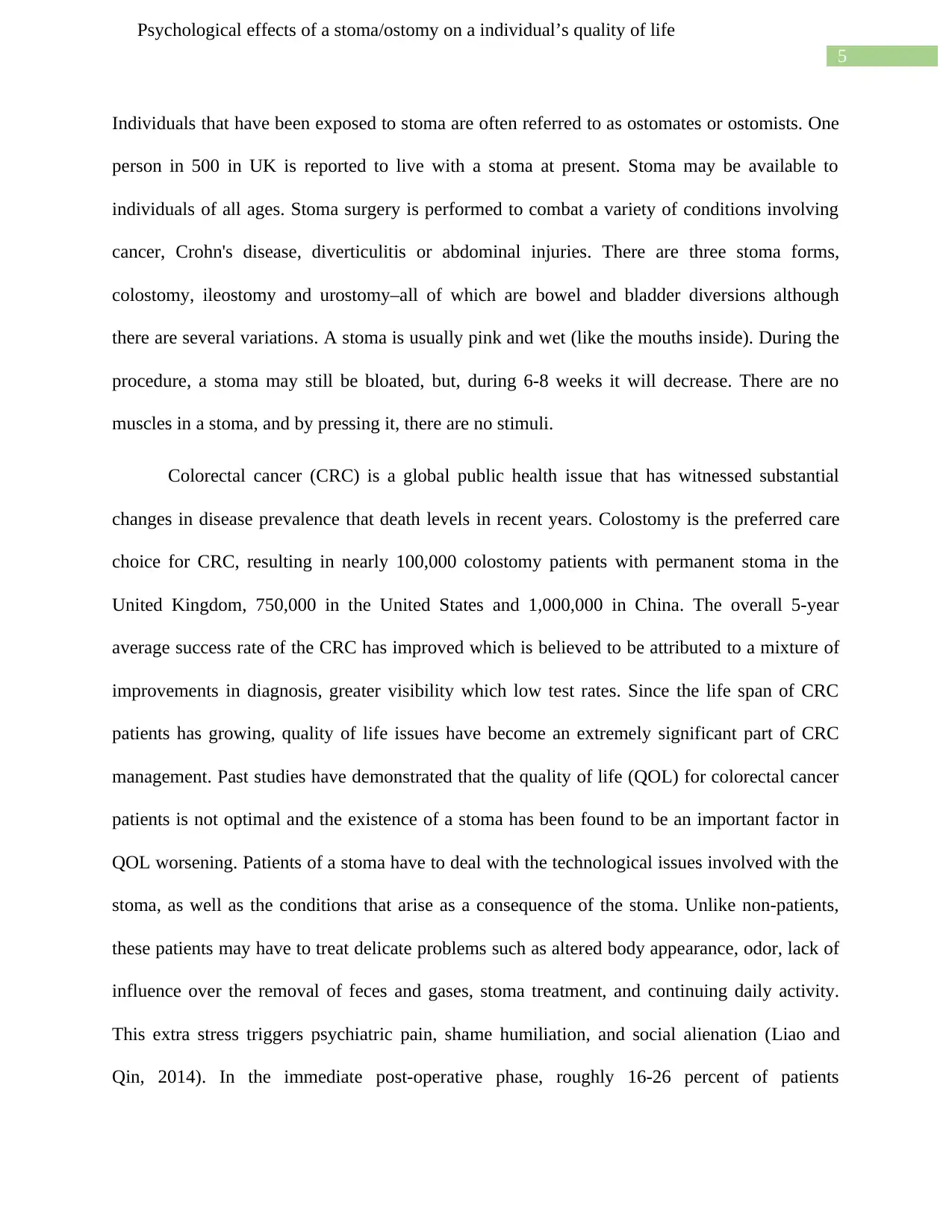
5
Psychological effects of a stoma/ostomy on a individual’s quality of life
Individuals that have been exposed to stoma are often referred to as ostomates or ostomists. One
person in 500 in UK is reported to live with a stoma at present. Stoma may be available to
individuals of all ages. Stoma surgery is performed to combat a variety of conditions involving
cancer, Crohn's disease, diverticulitis or abdominal injuries. There are three stoma forms,
colostomy, ileostomy and urostomy–all of which are bowel and bladder diversions although
there are several variations. A stoma is usually pink and wet (like the mouths inside). During the
procedure, a stoma may still be bloated, but, during 6-8 weeks it will decrease. There are no
muscles in a stoma, and by pressing it, there are no stimuli.
Colorectal cancer (CRC) is a global public health issue that has witnessed substantial
changes in disease prevalence that death levels in recent years. Colostomy is the preferred care
choice for CRC, resulting in nearly 100,000 colostomy patients with permanent stoma in the
United Kingdom, 750,000 in the United States and 1,000,000 in China. The overall 5-year
average success rate of the CRC has improved which is believed to be attributed to a mixture of
improvements in diagnosis, greater visibility which low test rates. Since the life span of CRC
patients has growing, quality of life issues have become an extremely significant part of CRC
management. Past studies have demonstrated that the quality of life (QOL) for colorectal cancer
patients is not optimal and the existence of a stoma has been found to be an important factor in
QOL worsening. Patients of a stoma have to deal with the technological issues involved with the
stoma, as well as the conditions that arise as a consequence of the stoma. Unlike non-patients,
these patients may have to treat delicate problems such as altered body appearance, odor, lack of
influence over the removal of feces and gases, stoma treatment, and continuing daily activity.
This extra stress triggers psychiatric pain, shame humiliation, and social alienation (Liao and
Qin, 2014). In the immediate post-operative phase, roughly 16-26 percent of patients
Psychological effects of a stoma/ostomy on a individual’s quality of life
Individuals that have been exposed to stoma are often referred to as ostomates or ostomists. One
person in 500 in UK is reported to live with a stoma at present. Stoma may be available to
individuals of all ages. Stoma surgery is performed to combat a variety of conditions involving
cancer, Crohn's disease, diverticulitis or abdominal injuries. There are three stoma forms,
colostomy, ileostomy and urostomy–all of which are bowel and bladder diversions although
there are several variations. A stoma is usually pink and wet (like the mouths inside). During the
procedure, a stoma may still be bloated, but, during 6-8 weeks it will decrease. There are no
muscles in a stoma, and by pressing it, there are no stimuli.
Colorectal cancer (CRC) is a global public health issue that has witnessed substantial
changes in disease prevalence that death levels in recent years. Colostomy is the preferred care
choice for CRC, resulting in nearly 100,000 colostomy patients with permanent stoma in the
United Kingdom, 750,000 in the United States and 1,000,000 in China. The overall 5-year
average success rate of the CRC has improved which is believed to be attributed to a mixture of
improvements in diagnosis, greater visibility which low test rates. Since the life span of CRC
patients has growing, quality of life issues have become an extremely significant part of CRC
management. Past studies have demonstrated that the quality of life (QOL) for colorectal cancer
patients is not optimal and the existence of a stoma has been found to be an important factor in
QOL worsening. Patients of a stoma have to deal with the technological issues involved with the
stoma, as well as the conditions that arise as a consequence of the stoma. Unlike non-patients,
these patients may have to treat delicate problems such as altered body appearance, odor, lack of
influence over the removal of feces and gases, stoma treatment, and continuing daily activity.
This extra stress triggers psychiatric pain, shame humiliation, and social alienation (Liao and
Qin, 2014). In the immediate post-operative phase, roughly 16-26 percent of patients
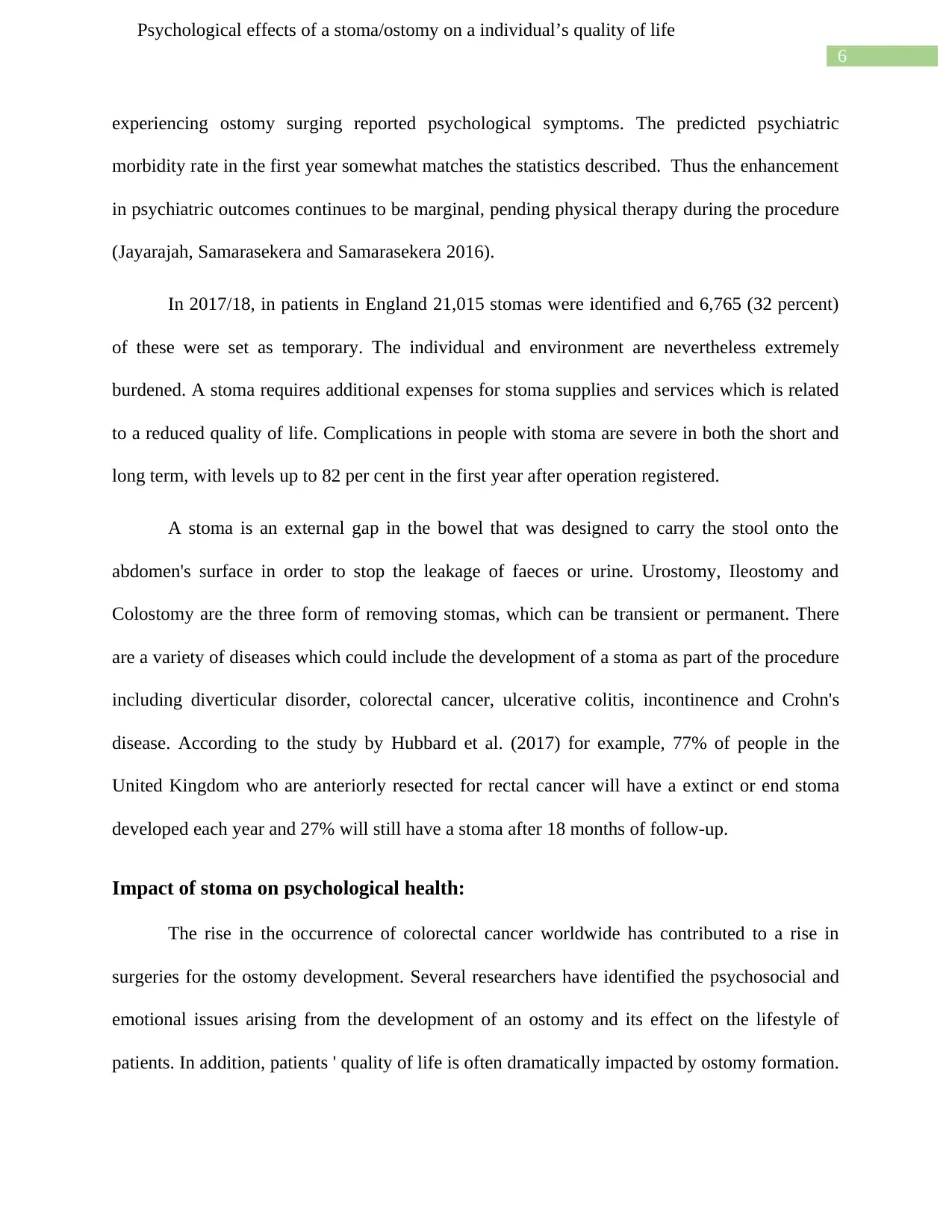
6
Psychological effects of a stoma/ostomy on a individual’s quality of life
experiencing ostomy surging reported psychological symptoms. The predicted psychiatric
morbidity rate in the first year somewhat matches the statistics described. Thus the enhancement
in psychiatric outcomes continues to be marginal, pending physical therapy during the procedure
(Jayarajah, Samarasekera and Samarasekera 2016).
In 2017/18, in patients in England 21,015 stomas were identified and 6,765 (32 percent)
of these were set as temporary. The individual and environment are nevertheless extremely
burdened. A stoma requires additional expenses for stoma supplies and services which is related
to a reduced quality of life. Complications in people with stoma are severe in both the short and
long term, with levels up to 82 per cent in the first year after operation registered.
A stoma is an external gap in the bowel that was designed to carry the stool onto the
abdomen's surface in order to stop the leakage of faeces or urine. Urostomy, Ileostomy and
Colostomy are the three form of removing stomas, which can be transient or permanent. There
are a variety of diseases which could include the development of a stoma as part of the procedure
including diverticular disorder, colorectal cancer, ulcerative colitis, incontinence and Crohn's
disease. According to the study by Hubbard et al. (2017) for example, 77% of people in the
United Kingdom who are anteriorly resected for rectal cancer will have a extinct or end stoma
developed each year and 27% will still have a stoma after 18 months of follow-up.
Impact of stoma on psychological health:
The rise in the occurrence of colorectal cancer worldwide has contributed to a rise in
surgeries for the ostomy development. Several researchers have identified the psychosocial and
emotional issues arising from the development of an ostomy and its effect on the lifestyle of
patients. In addition, patients ' quality of life is often dramatically impacted by ostomy formation.
Psychological effects of a stoma/ostomy on a individual’s quality of life
experiencing ostomy surging reported psychological symptoms. The predicted psychiatric
morbidity rate in the first year somewhat matches the statistics described. Thus the enhancement
in psychiatric outcomes continues to be marginal, pending physical therapy during the procedure
(Jayarajah, Samarasekera and Samarasekera 2016).
In 2017/18, in patients in England 21,015 stomas were identified and 6,765 (32 percent)
of these were set as temporary. The individual and environment are nevertheless extremely
burdened. A stoma requires additional expenses for stoma supplies and services which is related
to a reduced quality of life. Complications in people with stoma are severe in both the short and
long term, with levels up to 82 per cent in the first year after operation registered.
A stoma is an external gap in the bowel that was designed to carry the stool onto the
abdomen's surface in order to stop the leakage of faeces or urine. Urostomy, Ileostomy and
Colostomy are the three form of removing stomas, which can be transient or permanent. There
are a variety of diseases which could include the development of a stoma as part of the procedure
including diverticular disorder, colorectal cancer, ulcerative colitis, incontinence and Crohn's
disease. According to the study by Hubbard et al. (2017) for example, 77% of people in the
United Kingdom who are anteriorly resected for rectal cancer will have a extinct or end stoma
developed each year and 27% will still have a stoma after 18 months of follow-up.
Impact of stoma on psychological health:
The rise in the occurrence of colorectal cancer worldwide has contributed to a rise in
surgeries for the ostomy development. Several researchers have identified the psychosocial and
emotional issues arising from the development of an ostomy and its effect on the lifestyle of
patients. In addition, patients ' quality of life is often dramatically impacted by ostomy formation.
Paraphrase This Document
Need a fresh take? Get an instant paraphrase of this document with our AI Paraphraser
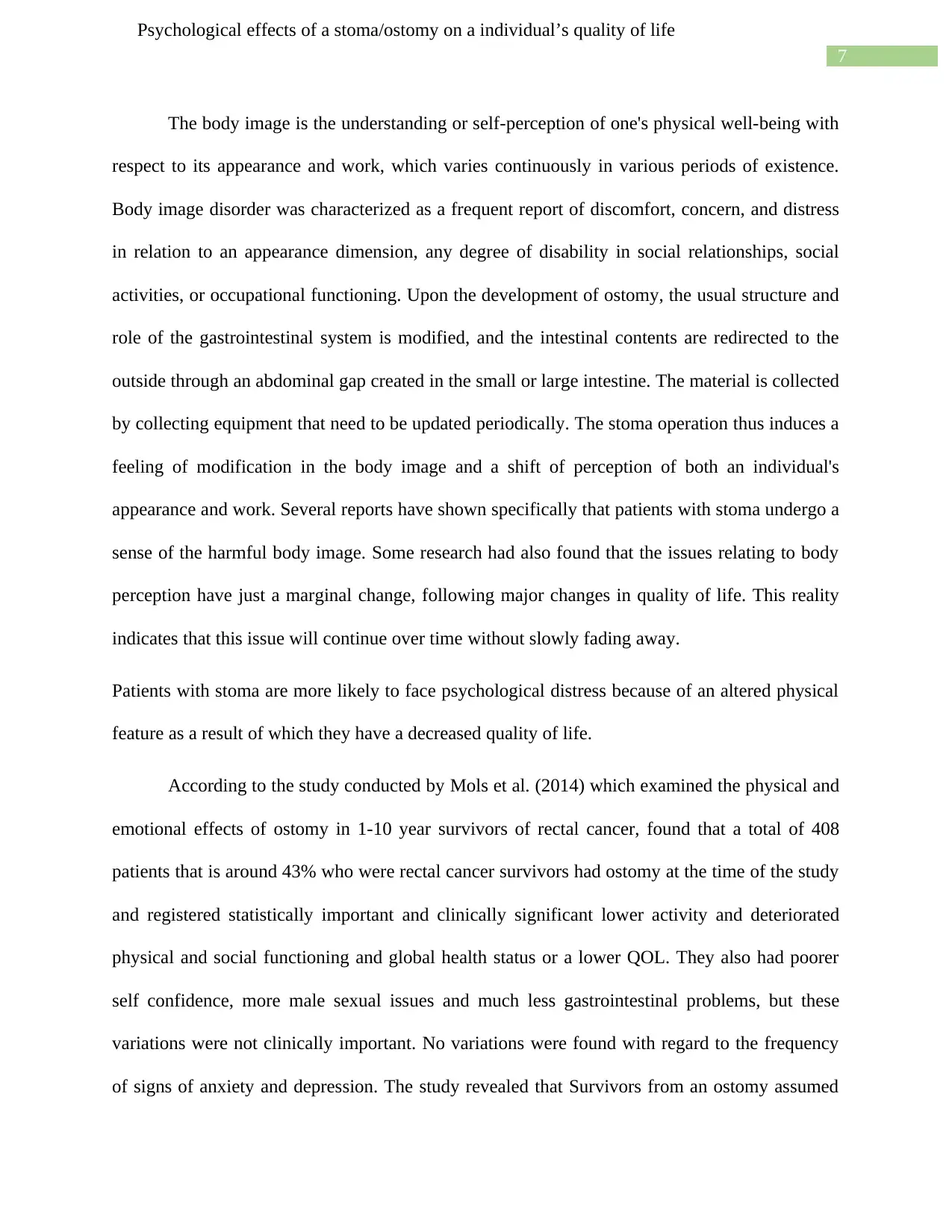
7
Psychological effects of a stoma/ostomy on a individual’s quality of life
The body image is the understanding or self-perception of one's physical well-being with
respect to its appearance and work, which varies continuously in various periods of existence.
Body image disorder was characterized as a frequent report of discomfort, concern, and distress
in relation to an appearance dimension, any degree of disability in social relationships, social
activities, or occupational functioning. Upon the development of ostomy, the usual structure and
role of the gastrointestinal system is modified, and the intestinal contents are redirected to the
outside through an abdominal gap created in the small or large intestine. The material is collected
by collecting equipment that need to be updated periodically. The stoma operation thus induces a
feeling of modification in the body image and a shift of perception of both an individual's
appearance and work. Several reports have shown specifically that patients with stoma undergo a
sense of the harmful body image. Some research had also found that the issues relating to body
perception have just a marginal change, following major changes in quality of life. This reality
indicates that this issue will continue over time without slowly fading away.
Patients with stoma are more likely to face psychological distress because of an altered physical
feature as a result of which they have a decreased quality of life.
According to the study conducted by Mols et al. (2014) which examined the physical and
emotional effects of ostomy in 1-10 year survivors of rectal cancer, found that a total of 408
patients that is around 43% who were rectal cancer survivors had ostomy at the time of the study
and registered statistically important and clinically significant lower activity and deteriorated
physical and social functioning and global health status or a lower QOL. They also had poorer
self confidence, more male sexual issues and much less gastrointestinal problems, but these
variations were not clinically important. No variations were found with regard to the frequency
of signs of anxiety and depression. The study revealed that Survivors from an ostomy assumed
Psychological effects of a stoma/ostomy on a individual’s quality of life
The body image is the understanding or self-perception of one's physical well-being with
respect to its appearance and work, which varies continuously in various periods of existence.
Body image disorder was characterized as a frequent report of discomfort, concern, and distress
in relation to an appearance dimension, any degree of disability in social relationships, social
activities, or occupational functioning. Upon the development of ostomy, the usual structure and
role of the gastrointestinal system is modified, and the intestinal contents are redirected to the
outside through an abdominal gap created in the small or large intestine. The material is collected
by collecting equipment that need to be updated periodically. The stoma operation thus induces a
feeling of modification in the body image and a shift of perception of both an individual's
appearance and work. Several reports have shown specifically that patients with stoma undergo a
sense of the harmful body image. Some research had also found that the issues relating to body
perception have just a marginal change, following major changes in quality of life. This reality
indicates that this issue will continue over time without slowly fading away.
Patients with stoma are more likely to face psychological distress because of an altered physical
feature as a result of which they have a decreased quality of life.
According to the study conducted by Mols et al. (2014) which examined the physical and
emotional effects of ostomy in 1-10 year survivors of rectal cancer, found that a total of 408
patients that is around 43% who were rectal cancer survivors had ostomy at the time of the study
and registered statistically important and clinically significant lower activity and deteriorated
physical and social functioning and global health status or a lower QOL. They also had poorer
self confidence, more male sexual issues and much less gastrointestinal problems, but these
variations were not clinically important. No variations were found with regard to the frequency
of signs of anxiety and depression. The study revealed that Survivors from an ostomy assumed
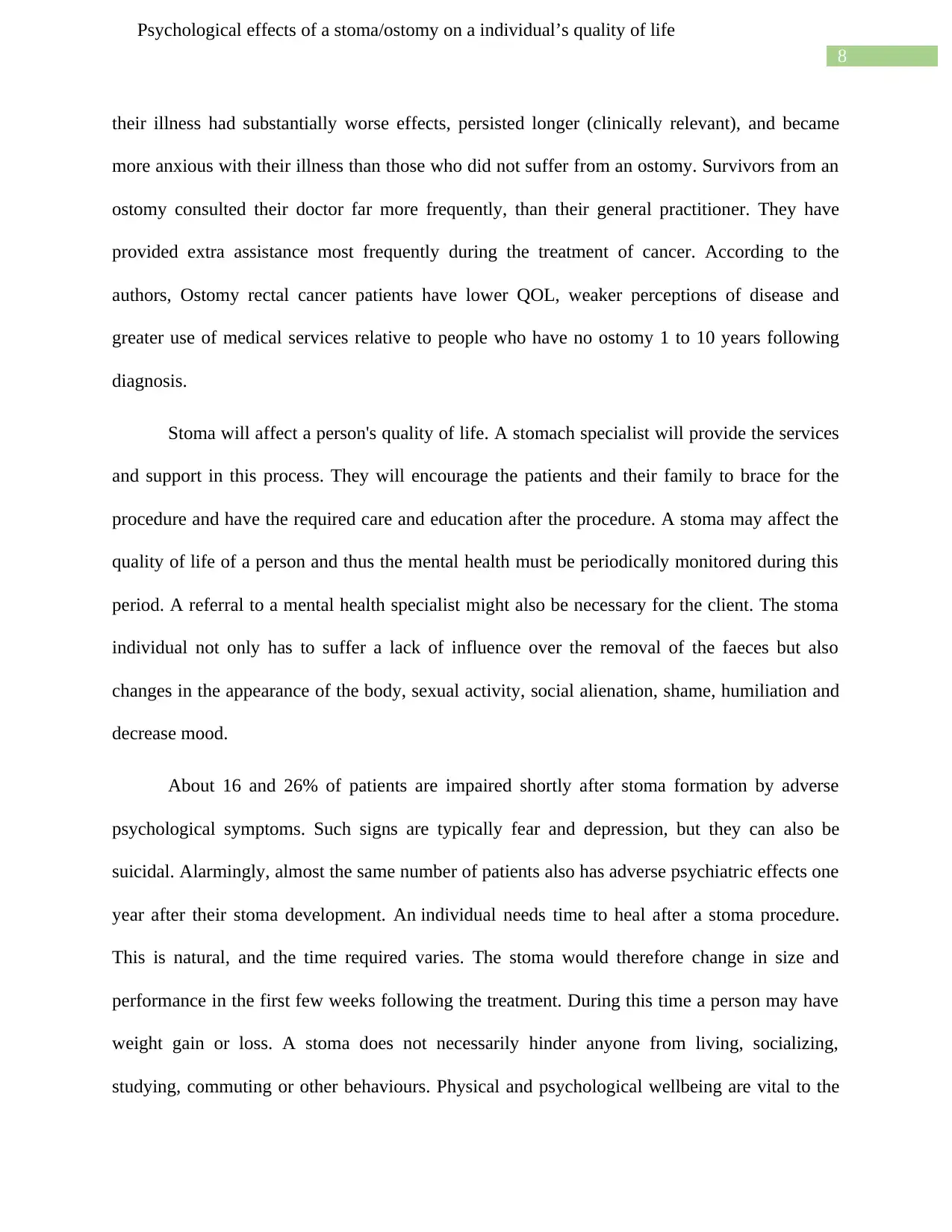
8
Psychological effects of a stoma/ostomy on a individual’s quality of life
their illness had substantially worse effects, persisted longer (clinically relevant), and became
more anxious with their illness than those who did not suffer from an ostomy. Survivors from an
ostomy consulted their doctor far more frequently, than their general practitioner. They have
provided extra assistance most frequently during the treatment of cancer. According to the
authors, Ostomy rectal cancer patients have lower QOL, weaker perceptions of disease and
greater use of medical services relative to people who have no ostomy 1 to 10 years following
diagnosis.
Stoma will affect a person's quality of life. A stomach specialist will provide the services
and support in this process. They will encourage the patients and their family to brace for the
procedure and have the required care and education after the procedure. A stoma may affect the
quality of life of a person and thus the mental health must be periodically monitored during this
period. A referral to a mental health specialist might also be necessary for the client. The stoma
individual not only has to suffer a lack of influence over the removal of the faeces but also
changes in the appearance of the body, sexual activity, social alienation, shame, humiliation and
decrease mood.
About 16 and 26% of patients are impaired shortly after stoma formation by adverse
psychological symptoms. Such signs are typically fear and depression, but they can also be
suicidal. Alarmingly, almost the same number of patients also has adverse psychiatric effects one
year after their stoma development. An individual needs time to heal after a stoma procedure.
This is natural, and the time required varies. The stoma would therefore change in size and
performance in the first few weeks following the treatment. During this time a person may have
weight gain or loss. A stoma does not necessarily hinder anyone from living, socializing,
studying, commuting or other behaviours. Physical and psychological wellbeing are vital to the
Psychological effects of a stoma/ostomy on a individual’s quality of life
their illness had substantially worse effects, persisted longer (clinically relevant), and became
more anxious with their illness than those who did not suffer from an ostomy. Survivors from an
ostomy consulted their doctor far more frequently, than their general practitioner. They have
provided extra assistance most frequently during the treatment of cancer. According to the
authors, Ostomy rectal cancer patients have lower QOL, weaker perceptions of disease and
greater use of medical services relative to people who have no ostomy 1 to 10 years following
diagnosis.
Stoma will affect a person's quality of life. A stomach specialist will provide the services
and support in this process. They will encourage the patients and their family to brace for the
procedure and have the required care and education after the procedure. A stoma may affect the
quality of life of a person and thus the mental health must be periodically monitored during this
period. A referral to a mental health specialist might also be necessary for the client. The stoma
individual not only has to suffer a lack of influence over the removal of the faeces but also
changes in the appearance of the body, sexual activity, social alienation, shame, humiliation and
decrease mood.
About 16 and 26% of patients are impaired shortly after stoma formation by adverse
psychological symptoms. Such signs are typically fear and depression, but they can also be
suicidal. Alarmingly, almost the same number of patients also has adverse psychiatric effects one
year after their stoma development. An individual needs time to heal after a stoma procedure.
This is natural, and the time required varies. The stoma would therefore change in size and
performance in the first few weeks following the treatment. During this time a person may have
weight gain or loss. A stoma does not necessarily hinder anyone from living, socializing,
studying, commuting or other behaviours. Physical and psychological wellbeing are vital to the
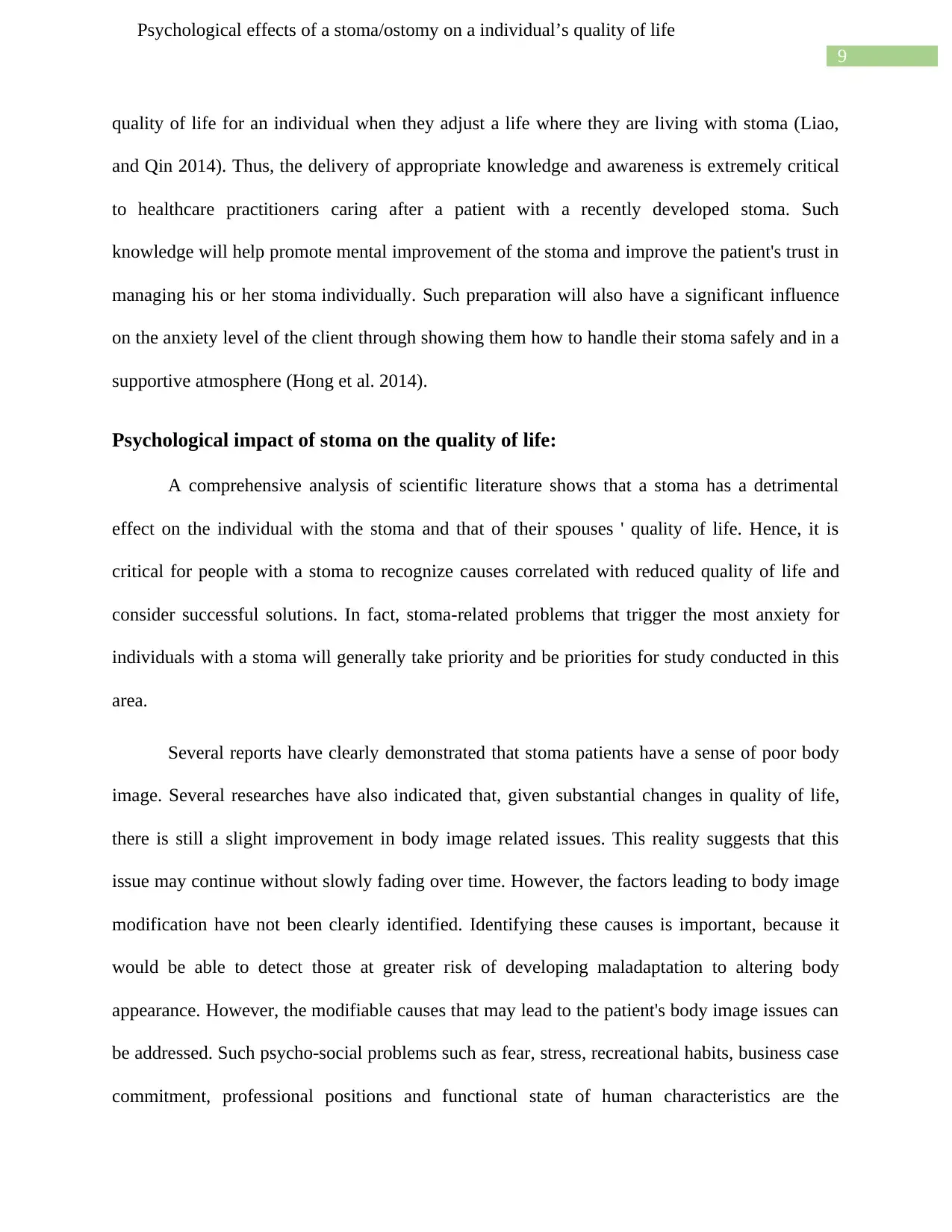
9
Psychological effects of a stoma/ostomy on a individual’s quality of life
quality of life for an individual when they adjust a life where they are living with stoma (Liao,
and Qin 2014). Thus, the delivery of appropriate knowledge and awareness is extremely critical
to healthcare practitioners caring after a patient with a recently developed stoma. Such
knowledge will help promote mental improvement of the stoma and improve the patient's trust in
managing his or her stoma individually. Such preparation will also have a significant influence
on the anxiety level of the client through showing them how to handle their stoma safely and in a
supportive atmosphere (Hong et al. 2014).
Psychological impact of stoma on the quality of life:
A comprehensive analysis of scientific literature shows that a stoma has a detrimental
effect on the individual with the stoma and that of their spouses ' quality of life. Hence, it is
critical for people with a stoma to recognize causes correlated with reduced quality of life and
consider successful solutions. In fact, stoma-related problems that trigger the most anxiety for
individuals with a stoma will generally take priority and be priorities for study conducted in this
area.
Several reports have clearly demonstrated that stoma patients have a sense of poor body
image. Several researches have also indicated that, given substantial changes in quality of life,
there is still a slight improvement in body image related issues. This reality suggests that this
issue may continue without slowly fading over time. However, the factors leading to body image
modification have not been clearly identified. Identifying these causes is important, because it
would be able to detect those at greater risk of developing maladaptation to altering body
appearance. However, the modifiable causes that may lead to the patient's body image issues can
be addressed. Such psycho-social problems such as fear, stress, recreational habits, business case
commitment, professional positions and functional state of human characteristics are the
Psychological effects of a stoma/ostomy on a individual’s quality of life
quality of life for an individual when they adjust a life where they are living with stoma (Liao,
and Qin 2014). Thus, the delivery of appropriate knowledge and awareness is extremely critical
to healthcare practitioners caring after a patient with a recently developed stoma. Such
knowledge will help promote mental improvement of the stoma and improve the patient's trust in
managing his or her stoma individually. Such preparation will also have a significant influence
on the anxiety level of the client through showing them how to handle their stoma safely and in a
supportive atmosphere (Hong et al. 2014).
Psychological impact of stoma on the quality of life:
A comprehensive analysis of scientific literature shows that a stoma has a detrimental
effect on the individual with the stoma and that of their spouses ' quality of life. Hence, it is
critical for people with a stoma to recognize causes correlated with reduced quality of life and
consider successful solutions. In fact, stoma-related problems that trigger the most anxiety for
individuals with a stoma will generally take priority and be priorities for study conducted in this
area.
Several reports have clearly demonstrated that stoma patients have a sense of poor body
image. Several researches have also indicated that, given substantial changes in quality of life,
there is still a slight improvement in body image related issues. This reality suggests that this
issue may continue without slowly fading over time. However, the factors leading to body image
modification have not been clearly identified. Identifying these causes is important, because it
would be able to detect those at greater risk of developing maladaptation to altering body
appearance. However, the modifiable causes that may lead to the patient's body image issues can
be addressed. Such psycho-social problems such as fear, stress, recreational habits, business case
commitment, professional positions and functional state of human characteristics are the
Secure Best Marks with AI Grader
Need help grading? Try our AI Grader for instant feedback on your assignments.
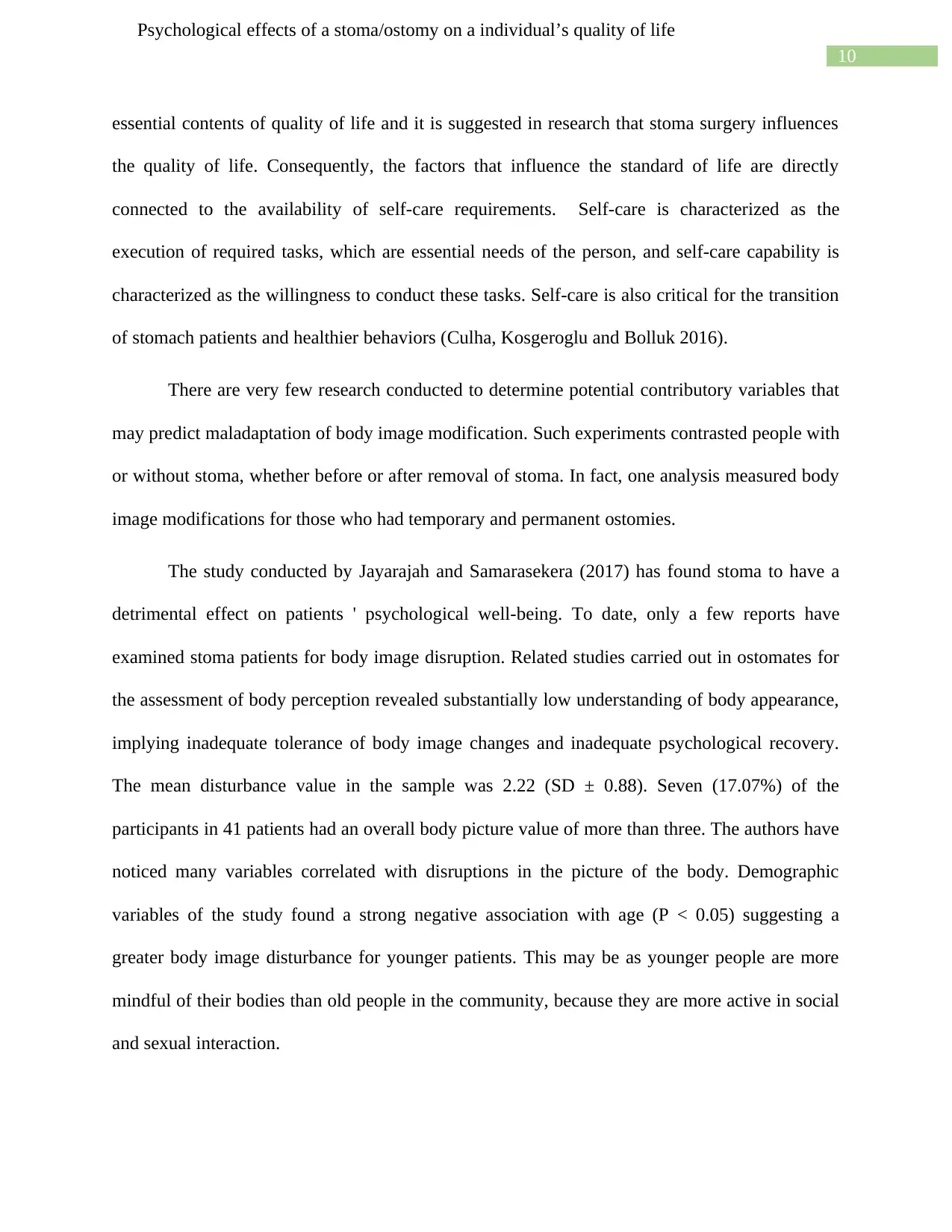
10
Psychological effects of a stoma/ostomy on a individual’s quality of life
essential contents of quality of life and it is suggested in research that stoma surgery influences
the quality of life. Consequently, the factors that influence the standard of life are directly
connected to the availability of self-care requirements. Self-care is characterized as the
execution of required tasks, which are essential needs of the person, and self-care capability is
characterized as the willingness to conduct these tasks. Self-care is also critical for the transition
of stomach patients and healthier behaviors (Culha, Kosgeroglu and Bolluk 2016).
There are very few research conducted to determine potential contributory variables that
may predict maladaptation of body image modification. Such experiments contrasted people with
or without stoma, whether before or after removal of stoma. In fact, one analysis measured body
image modifications for those who had temporary and permanent ostomies.
The study conducted by Jayarajah and Samarasekera (2017) has found stoma to have a
detrimental effect on patients ' psychological well-being. To date, only a few reports have
examined stoma patients for body image disruption. Related studies carried out in ostomates for
the assessment of body perception revealed substantially low understanding of body appearance,
implying inadequate tolerance of body image changes and inadequate psychological recovery.
The mean disturbance value in the sample was 2.22 (SD ± 0.88). Seven (17.07%) of the
participants in 41 patients had an overall body picture value of more than three. The authors have
noticed many variables correlated with disruptions in the picture of the body. Demographic
variables of the study found a strong negative association with age (P < 0.05) suggesting a
greater body image disturbance for younger patients. This may be as younger people are more
mindful of their bodies than old people in the community, because they are more active in social
and sexual interaction.
Psychological effects of a stoma/ostomy on a individual’s quality of life
essential contents of quality of life and it is suggested in research that stoma surgery influences
the quality of life. Consequently, the factors that influence the standard of life are directly
connected to the availability of self-care requirements. Self-care is characterized as the
execution of required tasks, which are essential needs of the person, and self-care capability is
characterized as the willingness to conduct these tasks. Self-care is also critical for the transition
of stomach patients and healthier behaviors (Culha, Kosgeroglu and Bolluk 2016).
There are very few research conducted to determine potential contributory variables that
may predict maladaptation of body image modification. Such experiments contrasted people with
or without stoma, whether before or after removal of stoma. In fact, one analysis measured body
image modifications for those who had temporary and permanent ostomies.
The study conducted by Jayarajah and Samarasekera (2017) has found stoma to have a
detrimental effect on patients ' psychological well-being. To date, only a few reports have
examined stoma patients for body image disruption. Related studies carried out in ostomates for
the assessment of body perception revealed substantially low understanding of body appearance,
implying inadequate tolerance of body image changes and inadequate psychological recovery.
The mean disturbance value in the sample was 2.22 (SD ± 0.88). Seven (17.07%) of the
participants in 41 patients had an overall body picture value of more than three. The authors have
noticed many variables correlated with disruptions in the picture of the body. Demographic
variables of the study found a strong negative association with age (P < 0.05) suggesting a
greater body image disturbance for younger patients. This may be as younger people are more
mindful of their bodies than old people in the community, because they are more active in social
and sexual interaction.
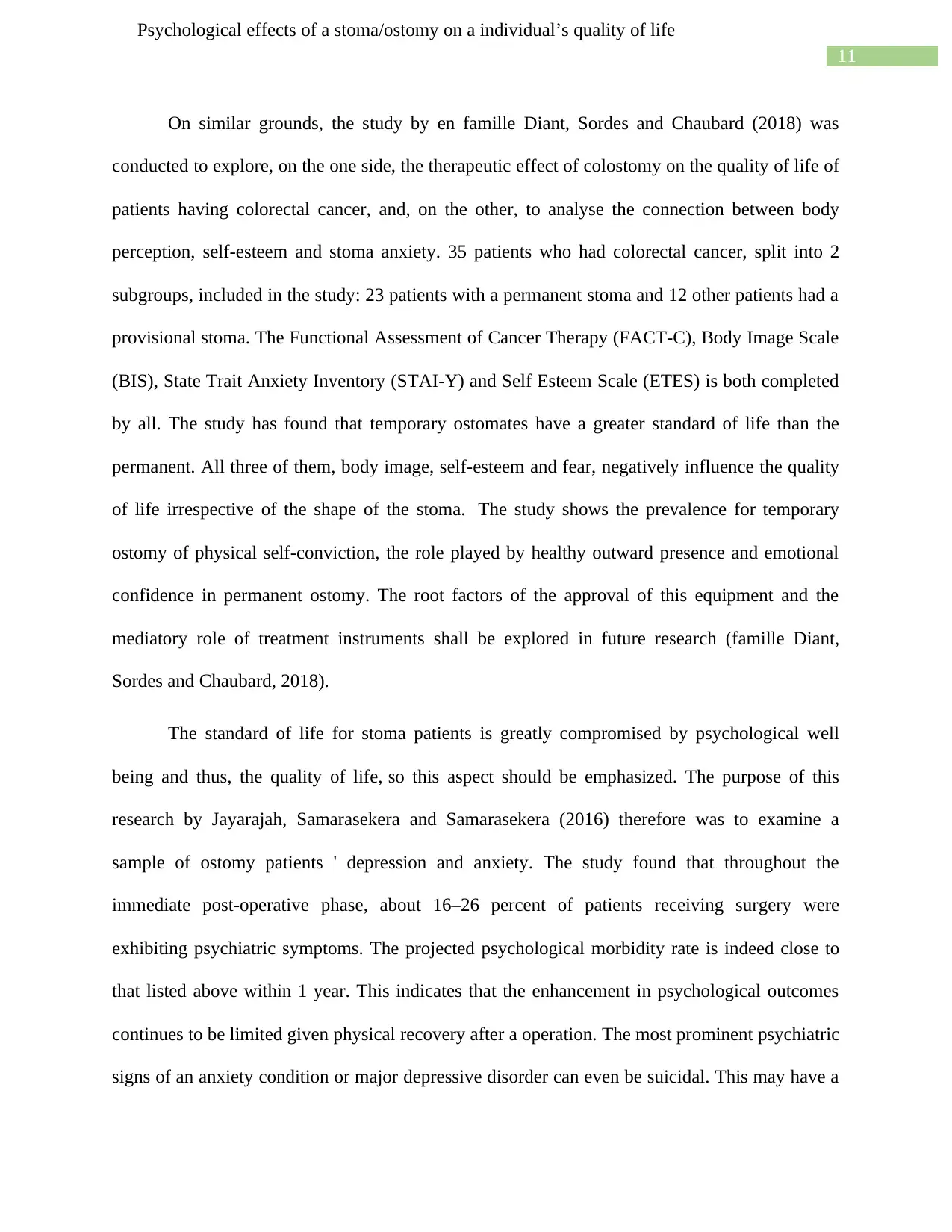
11
Psychological effects of a stoma/ostomy on a individual’s quality of life
On similar grounds, the study by en famille Diant, Sordes and Chaubard (2018) was
conducted to explore, on the one side, the therapeutic effect of colostomy on the quality of life of
patients having colorectal cancer, and, on the other, to analyse the connection between body
perception, self-esteem and stoma anxiety. 35 patients who had colorectal cancer, split into 2
subgroups, included in the study: 23 patients with a permanent stoma and 12 other patients had a
provisional stoma. The Functional Assessment of Cancer Therapy (FACT-C), Body Image Scale
(BIS), State Trait Anxiety Inventory (STAI-Y) and Self Esteem Scale (ETES) is both completed
by all. The study has found that temporary ostomates have a greater standard of life than the
permanent. All three of them, body image, self-esteem and fear, negatively influence the quality
of life irrespective of the shape of the stoma. The study shows the prevalence for temporary
ostomy of physical self-conviction, the role played by healthy outward presence and emotional
confidence in permanent ostomy. The root factors of the approval of this equipment and the
mediatory role of treatment instruments shall be explored in future research (famille Diant,
Sordes and Chaubard, 2018).
The standard of life for stoma patients is greatly compromised by psychological well
being and thus, the quality of life, so this aspect should be emphasized. The purpose of this
research by Jayarajah, Samarasekera and Samarasekera (2016) therefore was to examine a
sample of ostomy patients ' depression and anxiety. The study found that throughout the
immediate post-operative phase, about 16–26 percent of patients receiving surgery were
exhibiting psychiatric symptoms. The projected psychological morbidity rate is indeed close to
that listed above within 1 year. This indicates that the enhancement in psychological outcomes
continues to be limited given physical recovery after a operation. The most prominent psychiatric
signs of an anxiety condition or major depressive disorder can even be suicidal. This may have a
Psychological effects of a stoma/ostomy on a individual’s quality of life
On similar grounds, the study by en famille Diant, Sordes and Chaubard (2018) was
conducted to explore, on the one side, the therapeutic effect of colostomy on the quality of life of
patients having colorectal cancer, and, on the other, to analyse the connection between body
perception, self-esteem and stoma anxiety. 35 patients who had colorectal cancer, split into 2
subgroups, included in the study: 23 patients with a permanent stoma and 12 other patients had a
provisional stoma. The Functional Assessment of Cancer Therapy (FACT-C), Body Image Scale
(BIS), State Trait Anxiety Inventory (STAI-Y) and Self Esteem Scale (ETES) is both completed
by all. The study has found that temporary ostomates have a greater standard of life than the
permanent. All three of them, body image, self-esteem and fear, negatively influence the quality
of life irrespective of the shape of the stoma. The study shows the prevalence for temporary
ostomy of physical self-conviction, the role played by healthy outward presence and emotional
confidence in permanent ostomy. The root factors of the approval of this equipment and the
mediatory role of treatment instruments shall be explored in future research (famille Diant,
Sordes and Chaubard, 2018).
The standard of life for stoma patients is greatly compromised by psychological well
being and thus, the quality of life, so this aspect should be emphasized. The purpose of this
research by Jayarajah, Samarasekera and Samarasekera (2016) therefore was to examine a
sample of ostomy patients ' depression and anxiety. The study found that throughout the
immediate post-operative phase, about 16–26 percent of patients receiving surgery were
exhibiting psychiatric symptoms. The projected psychological morbidity rate is indeed close to
that listed above within 1 year. This indicates that the enhancement in psychological outcomes
continues to be limited given physical recovery after a operation. The most prominent psychiatric
signs of an anxiety condition or major depressive disorder can even be suicidal. This may have a
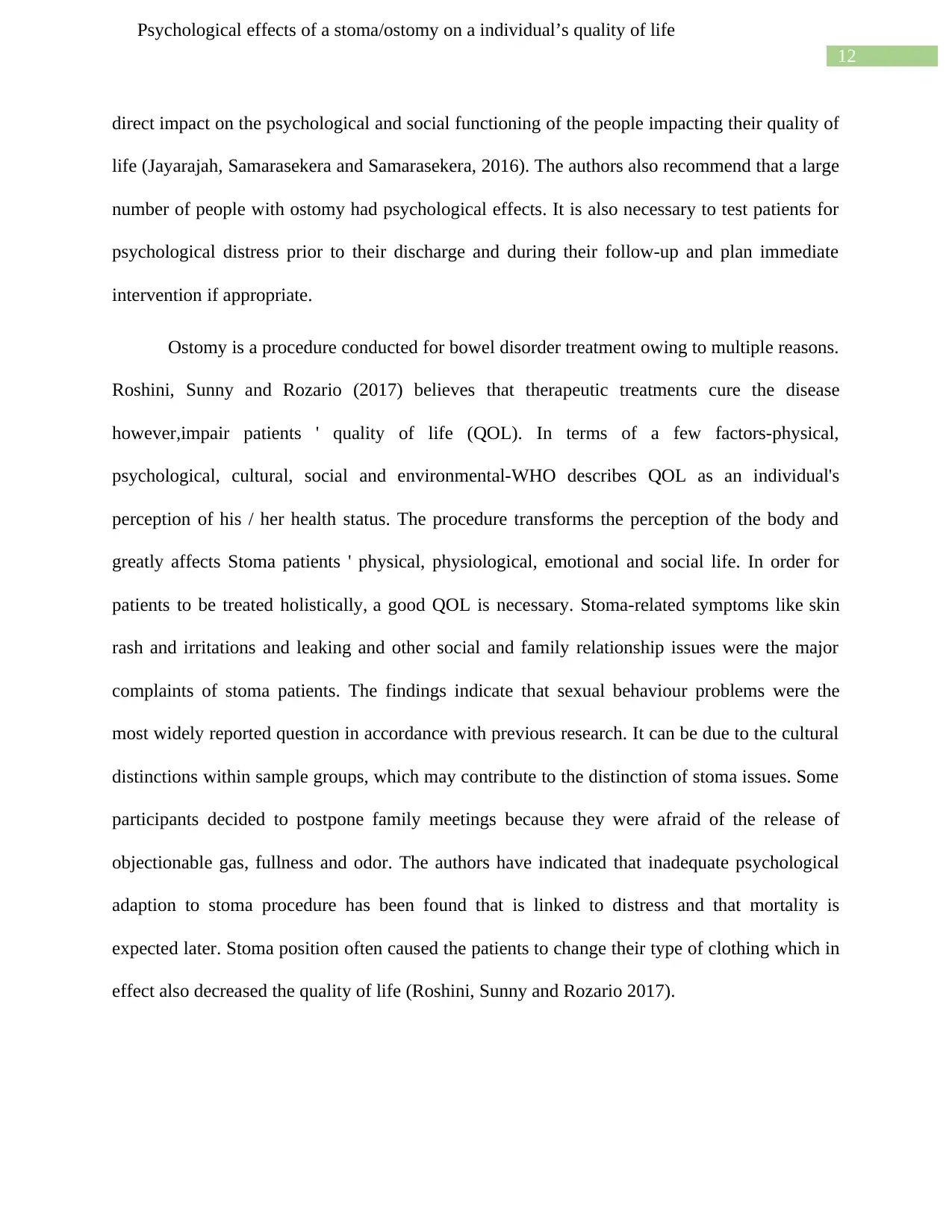
12
Psychological effects of a stoma/ostomy on a individual’s quality of life
direct impact on the psychological and social functioning of the people impacting their quality of
life (Jayarajah, Samarasekera and Samarasekera, 2016). The authors also recommend that a large
number of people with ostomy had psychological effects. It is also necessary to test patients for
psychological distress prior to their discharge and during their follow-up and plan immediate
intervention if appropriate.
Ostomy is a procedure conducted for bowel disorder treatment owing to multiple reasons.
Roshini, Sunny and Rozario (2017) believes that therapeutic treatments cure the disease
however,impair patients ' quality of life (QOL). In terms of a few factors-physical,
psychological, cultural, social and environmental-WHO describes QOL as an individual's
perception of his / her health status. The procedure transforms the perception of the body and
greatly affects Stoma patients ' physical, physiological, emotional and social life. In order for
patients to be treated holistically, a good QOL is necessary. Stoma-related symptoms like skin
rash and irritations and leaking and other social and family relationship issues were the major
complaints of stoma patients. The findings indicate that sexual behaviour problems were the
most widely reported question in accordance with previous research. It can be due to the cultural
distinctions within sample groups, which may contribute to the distinction of stoma issues. Some
participants decided to postpone family meetings because they were afraid of the release of
objectionable gas, fullness and odor. The authors have indicated that inadequate psychological
adaption to stoma procedure has been found that is linked to distress and that mortality is
expected later. Stoma position often caused the patients to change their type of clothing which in
effect also decreased the quality of life (Roshini, Sunny and Rozario 2017).
Psychological effects of a stoma/ostomy on a individual’s quality of life
direct impact on the psychological and social functioning of the people impacting their quality of
life (Jayarajah, Samarasekera and Samarasekera, 2016). The authors also recommend that a large
number of people with ostomy had psychological effects. It is also necessary to test patients for
psychological distress prior to their discharge and during their follow-up and plan immediate
intervention if appropriate.
Ostomy is a procedure conducted for bowel disorder treatment owing to multiple reasons.
Roshini, Sunny and Rozario (2017) believes that therapeutic treatments cure the disease
however,impair patients ' quality of life (QOL). In terms of a few factors-physical,
psychological, cultural, social and environmental-WHO describes QOL as an individual's
perception of his / her health status. The procedure transforms the perception of the body and
greatly affects Stoma patients ' physical, physiological, emotional and social life. In order for
patients to be treated holistically, a good QOL is necessary. Stoma-related symptoms like skin
rash and irritations and leaking and other social and family relationship issues were the major
complaints of stoma patients. The findings indicate that sexual behaviour problems were the
most widely reported question in accordance with previous research. It can be due to the cultural
distinctions within sample groups, which may contribute to the distinction of stoma issues. Some
participants decided to postpone family meetings because they were afraid of the release of
objectionable gas, fullness and odor. The authors have indicated that inadequate psychological
adaption to stoma procedure has been found that is linked to distress and that mortality is
expected later. Stoma position often caused the patients to change their type of clothing which in
effect also decreased the quality of life (Roshini, Sunny and Rozario 2017).
Paraphrase This Document
Need a fresh take? Get an instant paraphrase of this document with our AI Paraphraser
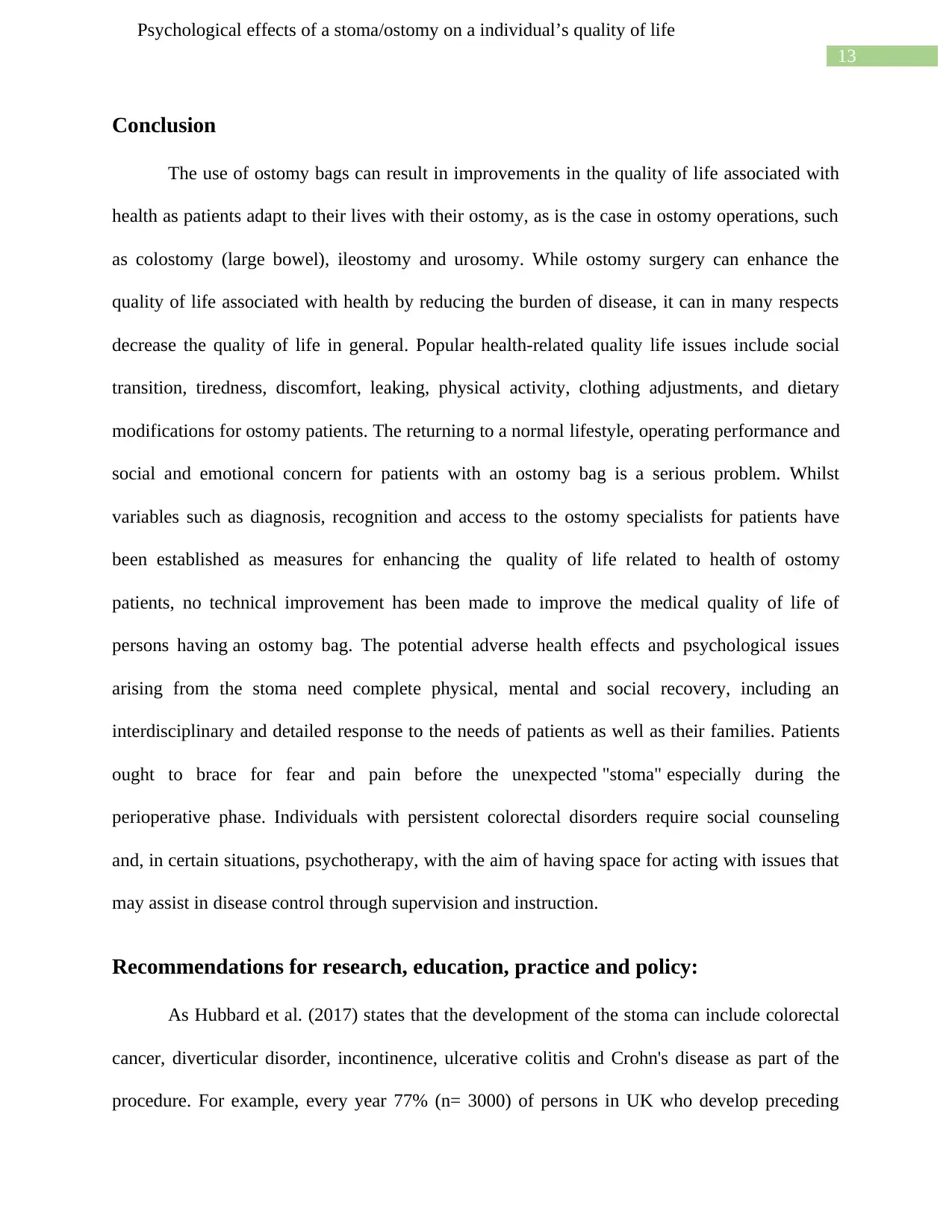
13
Psychological effects of a stoma/ostomy on a individual’s quality of life
Conclusion
The use of ostomy bags can result in improvements in the quality of life associated with
health as patients adapt to their lives with their ostomy, as is the case in ostomy operations, such
as colostomy (large bowel), ileostomy and urosomy. While ostomy surgery can enhance the
quality of life associated with health by reducing the burden of disease, it can in many respects
decrease the quality of life in general. Popular health-related quality life issues include social
transition, tiredness, discomfort, leaking, physical activity, clothing adjustments, and dietary
modifications for ostomy patients. The returning to a normal lifestyle, operating performance and
social and emotional concern for patients with an ostomy bag is a serious problem. Whilst
variables such as diagnosis, recognition and access to the ostomy specialists for patients have
been established as measures for enhancing the quality of life related to health of ostomy
patients, no technical improvement has been made to improve the medical quality of life of
persons having an ostomy bag. The potential adverse health effects and psychological issues
arising from the stoma need complete physical, mental and social recovery, including an
interdisciplinary and detailed response to the needs of patients as well as their families. Patients
ought to brace for fear and pain before the unexpected "stoma" especially during the
perioperative phase. Individuals with persistent colorectal disorders require social counseling
and, in certain situations, psychotherapy, with the aim of having space for acting with issues that
may assist in disease control through supervision and instruction.
Recommendations for research, education, practice and policy:
As Hubbard et al. (2017) states that the development of the stoma can include colorectal
cancer, diverticular disorder, incontinence, ulcerative colitis and Crohn's disease as part of the
procedure. For example, every year 77% (n= 3000) of persons in UK who develop preceding
Psychological effects of a stoma/ostomy on a individual’s quality of life
Conclusion
The use of ostomy bags can result in improvements in the quality of life associated with
health as patients adapt to their lives with their ostomy, as is the case in ostomy operations, such
as colostomy (large bowel), ileostomy and urosomy. While ostomy surgery can enhance the
quality of life associated with health by reducing the burden of disease, it can in many respects
decrease the quality of life in general. Popular health-related quality life issues include social
transition, tiredness, discomfort, leaking, physical activity, clothing adjustments, and dietary
modifications for ostomy patients. The returning to a normal lifestyle, operating performance and
social and emotional concern for patients with an ostomy bag is a serious problem. Whilst
variables such as diagnosis, recognition and access to the ostomy specialists for patients have
been established as measures for enhancing the quality of life related to health of ostomy
patients, no technical improvement has been made to improve the medical quality of life of
persons having an ostomy bag. The potential adverse health effects and psychological issues
arising from the stoma need complete physical, mental and social recovery, including an
interdisciplinary and detailed response to the needs of patients as well as their families. Patients
ought to brace for fear and pain before the unexpected "stoma" especially during the
perioperative phase. Individuals with persistent colorectal disorders require social counseling
and, in certain situations, psychotherapy, with the aim of having space for acting with issues that
may assist in disease control through supervision and instruction.
Recommendations for research, education, practice and policy:
As Hubbard et al. (2017) states that the development of the stoma can include colorectal
cancer, diverticular disorder, incontinence, ulcerative colitis and Crohn's disease as part of the
procedure. For example, every year 77% (n= 3000) of persons in UK who develop preceding
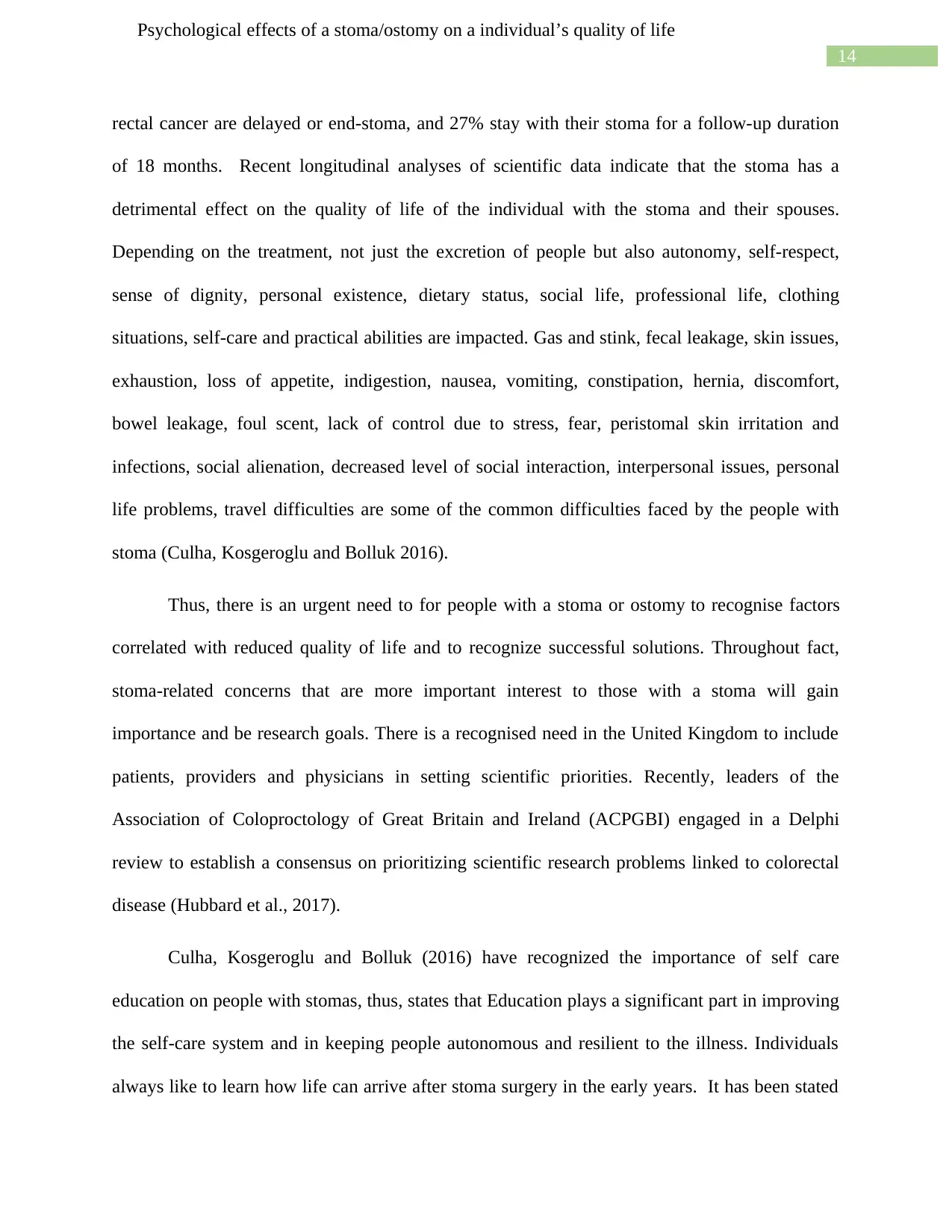
14
Psychological effects of a stoma/ostomy on a individual’s quality of life
rectal cancer are delayed or end-stoma, and 27% stay with their stoma for a follow-up duration
of 18 months. Recent longitudinal analyses of scientific data indicate that the stoma has a
detrimental effect on the quality of life of the individual with the stoma and their spouses.
Depending on the treatment, not just the excretion of people but also autonomy, self-respect,
sense of dignity, personal existence, dietary status, social life, professional life, clothing
situations, self-care and practical abilities are impacted. Gas and stink, fecal leakage, skin issues,
exhaustion, loss of appetite, indigestion, nausea, vomiting, constipation, hernia, discomfort,
bowel leakage, foul scent, lack of control due to stress, fear, peristomal skin irritation and
infections, social alienation, decreased level of social interaction, interpersonal issues, personal
life problems, travel difficulties are some of the common difficulties faced by the people with
stoma (Culha, Kosgeroglu and Bolluk 2016).
Thus, there is an urgent need to for people with a stoma or ostomy to recognise factors
correlated with reduced quality of life and to recognize successful solutions. Throughout fact,
stoma-related concerns that are more important interest to those with a stoma will gain
importance and be research goals. There is a recognised need in the United Kingdom to include
patients, providers and physicians in setting scientific priorities. Recently, leaders of the
Association of Coloproctology of Great Britain and Ireland (ACPGBI) engaged in a Delphi
review to establish a consensus on prioritizing scientific research problems linked to colorectal
disease (Hubbard et al., 2017).
Culha, Kosgeroglu and Bolluk (2016) have recognized the importance of self care
education on people with stomas, thus, states that Education plays a significant part in improving
the self-care system and in keeping people autonomous and resilient to the illness. Individuals
always like to learn how life can arrive after stoma surgery in the early years. It has been stated
Psychological effects of a stoma/ostomy on a individual’s quality of life
rectal cancer are delayed or end-stoma, and 27% stay with their stoma for a follow-up duration
of 18 months. Recent longitudinal analyses of scientific data indicate that the stoma has a
detrimental effect on the quality of life of the individual with the stoma and their spouses.
Depending on the treatment, not just the excretion of people but also autonomy, self-respect,
sense of dignity, personal existence, dietary status, social life, professional life, clothing
situations, self-care and practical abilities are impacted. Gas and stink, fecal leakage, skin issues,
exhaustion, loss of appetite, indigestion, nausea, vomiting, constipation, hernia, discomfort,
bowel leakage, foul scent, lack of control due to stress, fear, peristomal skin irritation and
infections, social alienation, decreased level of social interaction, interpersonal issues, personal
life problems, travel difficulties are some of the common difficulties faced by the people with
stoma (Culha, Kosgeroglu and Bolluk 2016).
Thus, there is an urgent need to for people with a stoma or ostomy to recognise factors
correlated with reduced quality of life and to recognize successful solutions. Throughout fact,
stoma-related concerns that are more important interest to those with a stoma will gain
importance and be research goals. There is a recognised need in the United Kingdom to include
patients, providers and physicians in setting scientific priorities. Recently, leaders of the
Association of Coloproctology of Great Britain and Ireland (ACPGBI) engaged in a Delphi
review to establish a consensus on prioritizing scientific research problems linked to colorectal
disease (Hubbard et al., 2017).
Culha, Kosgeroglu and Bolluk (2016) have recognized the importance of self care
education on people with stomas, thus, states that Education plays a significant part in improving
the self-care system and in keeping people autonomous and resilient to the illness. Individuals
always like to learn how life can arrive after stoma surgery in the early years. It has been stated
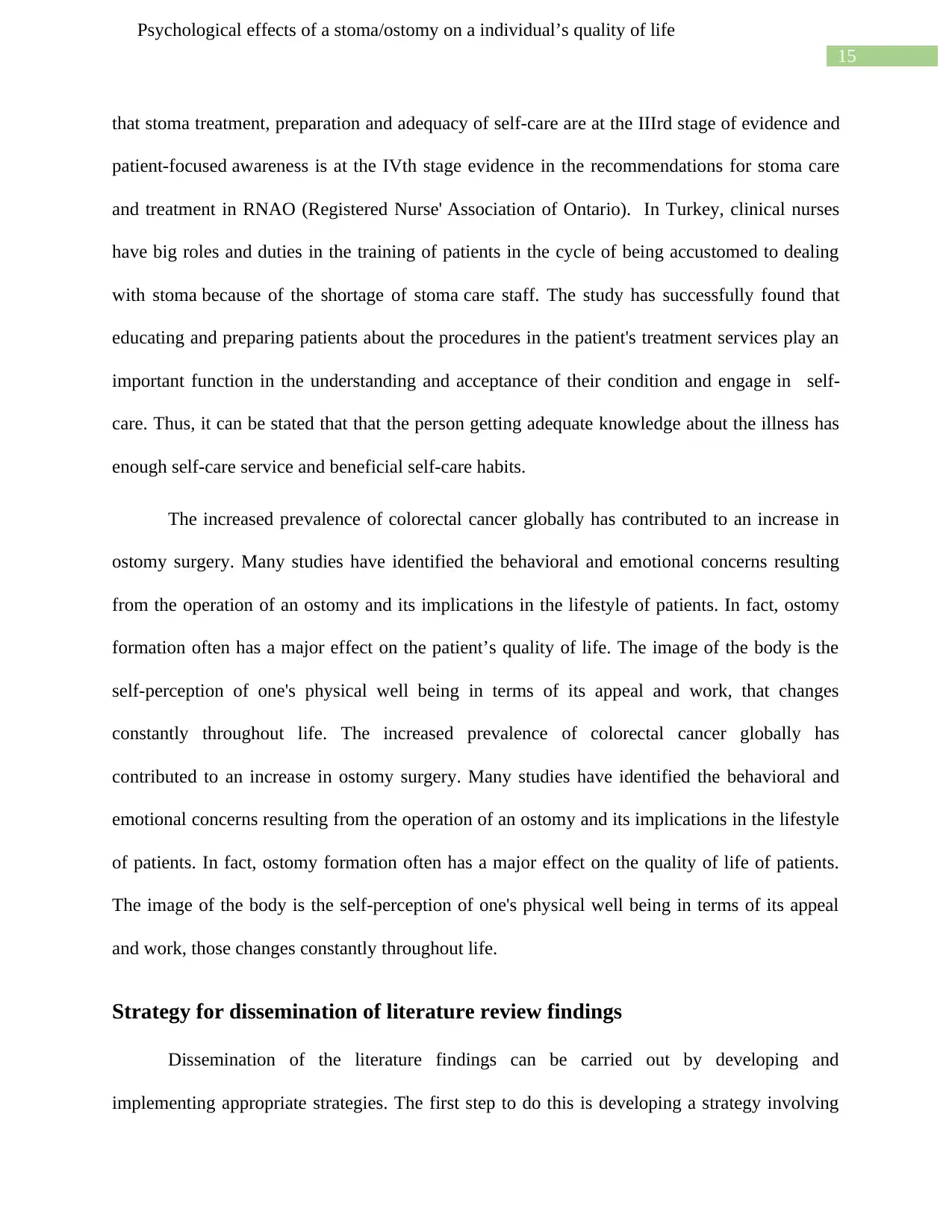
15
Psychological effects of a stoma/ostomy on a individual’s quality of life
that stoma treatment, preparation and adequacy of self-care are at the IIIrd stage of evidence and
patient-focused awareness is at the IVth stage evidence in the recommendations for stoma care
and treatment in RNAO (Registered Nurse' Association of Ontario). In Turkey, clinical nurses
have big roles and duties in the training of patients in the cycle of being accustomed to dealing
with stoma because of the shortage of stoma care staff. The study has successfully found that
educating and preparing patients about the procedures in the patient's treatment services play an
important function in the understanding and acceptance of their condition and engage in self-
care. Thus, it can be stated that that the person getting adequate knowledge about the illness has
enough self-care service and beneficial self-care habits.
The increased prevalence of colorectal cancer globally has contributed to an increase in
ostomy surgery. Many studies have identified the behavioral and emotional concerns resulting
from the operation of an ostomy and its implications in the lifestyle of patients. In fact, ostomy
formation often has a major effect on the patient’s quality of life. The image of the body is the
self-perception of one's physical well being in terms of its appeal and work, that changes
constantly throughout life. The increased prevalence of colorectal cancer globally has
contributed to an increase in ostomy surgery. Many studies have identified the behavioral and
emotional concerns resulting from the operation of an ostomy and its implications in the lifestyle
of patients. In fact, ostomy formation often has a major effect on the quality of life of patients.
The image of the body is the self-perception of one's physical well being in terms of its appeal
and work, those changes constantly throughout life.
Strategy for dissemination of literature review findings
Dissemination of the literature findings can be carried out by developing and
implementing appropriate strategies. The first step to do this is developing a strategy involving
Psychological effects of a stoma/ostomy on a individual’s quality of life
that stoma treatment, preparation and adequacy of self-care are at the IIIrd stage of evidence and
patient-focused awareness is at the IVth stage evidence in the recommendations for stoma care
and treatment in RNAO (Registered Nurse' Association of Ontario). In Turkey, clinical nurses
have big roles and duties in the training of patients in the cycle of being accustomed to dealing
with stoma because of the shortage of stoma care staff. The study has successfully found that
educating and preparing patients about the procedures in the patient's treatment services play an
important function in the understanding and acceptance of their condition and engage in self-
care. Thus, it can be stated that that the person getting adequate knowledge about the illness has
enough self-care service and beneficial self-care habits.
The increased prevalence of colorectal cancer globally has contributed to an increase in
ostomy surgery. Many studies have identified the behavioral and emotional concerns resulting
from the operation of an ostomy and its implications in the lifestyle of patients. In fact, ostomy
formation often has a major effect on the patient’s quality of life. The image of the body is the
self-perception of one's physical well being in terms of its appeal and work, that changes
constantly throughout life. The increased prevalence of colorectal cancer globally has
contributed to an increase in ostomy surgery. Many studies have identified the behavioral and
emotional concerns resulting from the operation of an ostomy and its implications in the lifestyle
of patients. In fact, ostomy formation often has a major effect on the quality of life of patients.
The image of the body is the self-perception of one's physical well being in terms of its appeal
and work, those changes constantly throughout life.
Strategy for dissemination of literature review findings
Dissemination of the literature findings can be carried out by developing and
implementing appropriate strategies. The first step to do this is developing a strategy involving
Secure Best Marks with AI Grader
Need help grading? Try our AI Grader for instant feedback on your assignments.
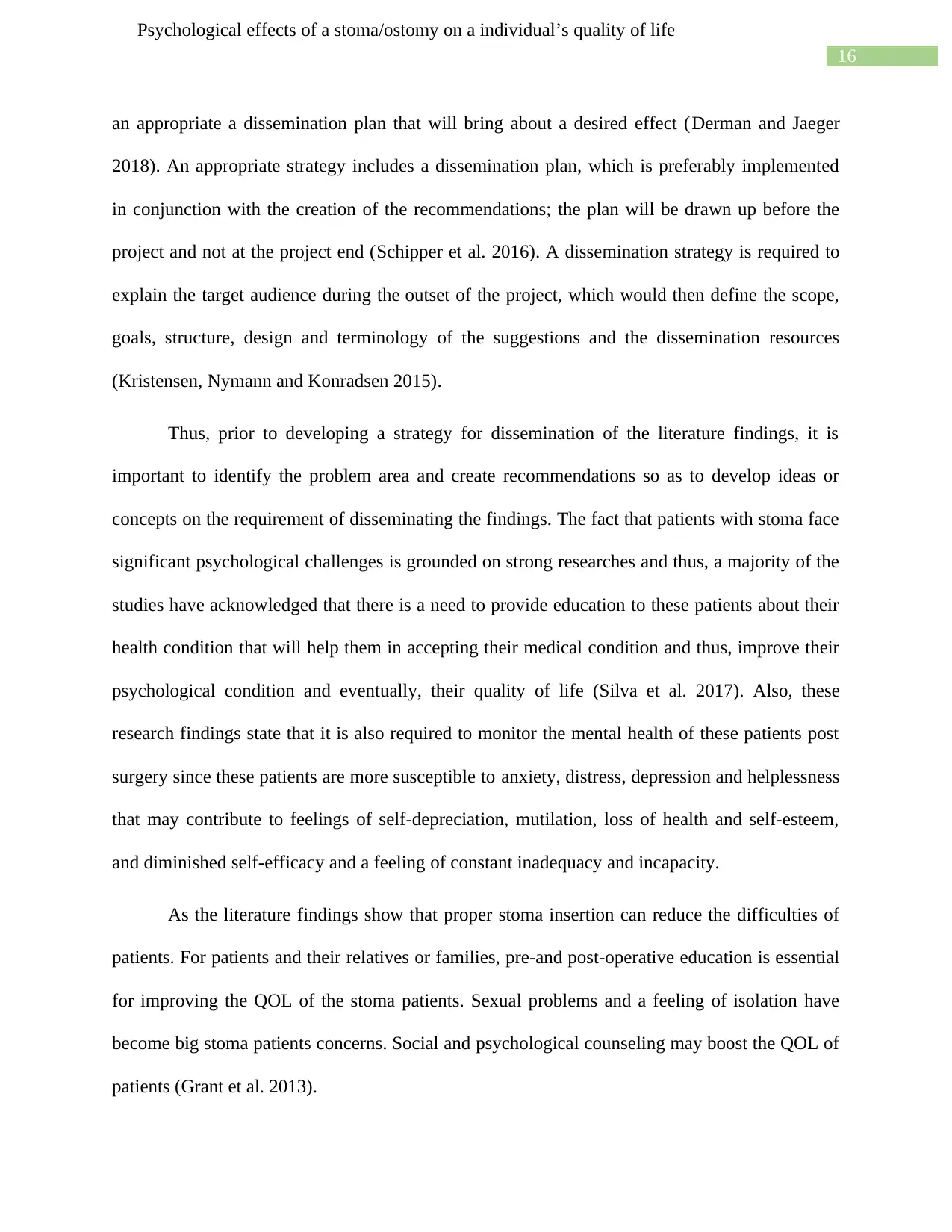
16
Psychological effects of a stoma/ostomy on a individual’s quality of life
an appropriate a dissemination plan that will bring about a desired effect (Derman and Jaeger
2018). An appropriate strategy includes a dissemination plan, which is preferably implemented
in conjunction with the creation of the recommendations; the plan will be drawn up before the
project and not at the project end (Schipper et al. 2016). A dissemination strategy is required to
explain the target audience during the outset of the project, which would then define the scope,
goals, structure, design and terminology of the suggestions and the dissemination resources
(Kristensen, Nymann and Konradsen 2015).
Thus, prior to developing a strategy for dissemination of the literature findings, it is
important to identify the problem area and create recommendations so as to develop ideas or
concepts on the requirement of disseminating the findings. The fact that patients with stoma face
significant psychological challenges is grounded on strong researches and thus, a majority of the
studies have acknowledged that there is a need to provide education to these patients about their
health condition that will help them in accepting their medical condition and thus, improve their
psychological condition and eventually, their quality of life (Silva et al. 2017). Also, these
research findings state that it is also required to monitor the mental health of these patients post
surgery since these patients are more susceptible to anxiety, distress, depression and helplessness
that may contribute to feelings of self-depreciation, mutilation, loss of health and self-esteem,
and diminished self-efficacy and a feeling of constant inadequacy and incapacity.
As the literature findings show that proper stoma insertion can reduce the difficulties of
patients. For patients and their relatives or families, pre-and post-operative education is essential
for improving the QOL of the stoma patients. Sexual problems and a feeling of isolation have
become big stoma patients concerns. Social and psychological counseling may boost the QOL of
patients (Grant et al. 2013).
Psychological effects of a stoma/ostomy on a individual’s quality of life
an appropriate a dissemination plan that will bring about a desired effect (Derman and Jaeger
2018). An appropriate strategy includes a dissemination plan, which is preferably implemented
in conjunction with the creation of the recommendations; the plan will be drawn up before the
project and not at the project end (Schipper et al. 2016). A dissemination strategy is required to
explain the target audience during the outset of the project, which would then define the scope,
goals, structure, design and terminology of the suggestions and the dissemination resources
(Kristensen, Nymann and Konradsen 2015).
Thus, prior to developing a strategy for dissemination of the literature findings, it is
important to identify the problem area and create recommendations so as to develop ideas or
concepts on the requirement of disseminating the findings. The fact that patients with stoma face
significant psychological challenges is grounded on strong researches and thus, a majority of the
studies have acknowledged that there is a need to provide education to these patients about their
health condition that will help them in accepting their medical condition and thus, improve their
psychological condition and eventually, their quality of life (Silva et al. 2017). Also, these
research findings state that it is also required to monitor the mental health of these patients post
surgery since these patients are more susceptible to anxiety, distress, depression and helplessness
that may contribute to feelings of self-depreciation, mutilation, loss of health and self-esteem,
and diminished self-efficacy and a feeling of constant inadequacy and incapacity.
As the literature findings show that proper stoma insertion can reduce the difficulties of
patients. For patients and their relatives or families, pre-and post-operative education is essential
for improving the QOL of the stoma patients. Sexual problems and a feeling of isolation have
become big stoma patients concerns. Social and psychological counseling may boost the QOL of
patients (Grant et al. 2013).
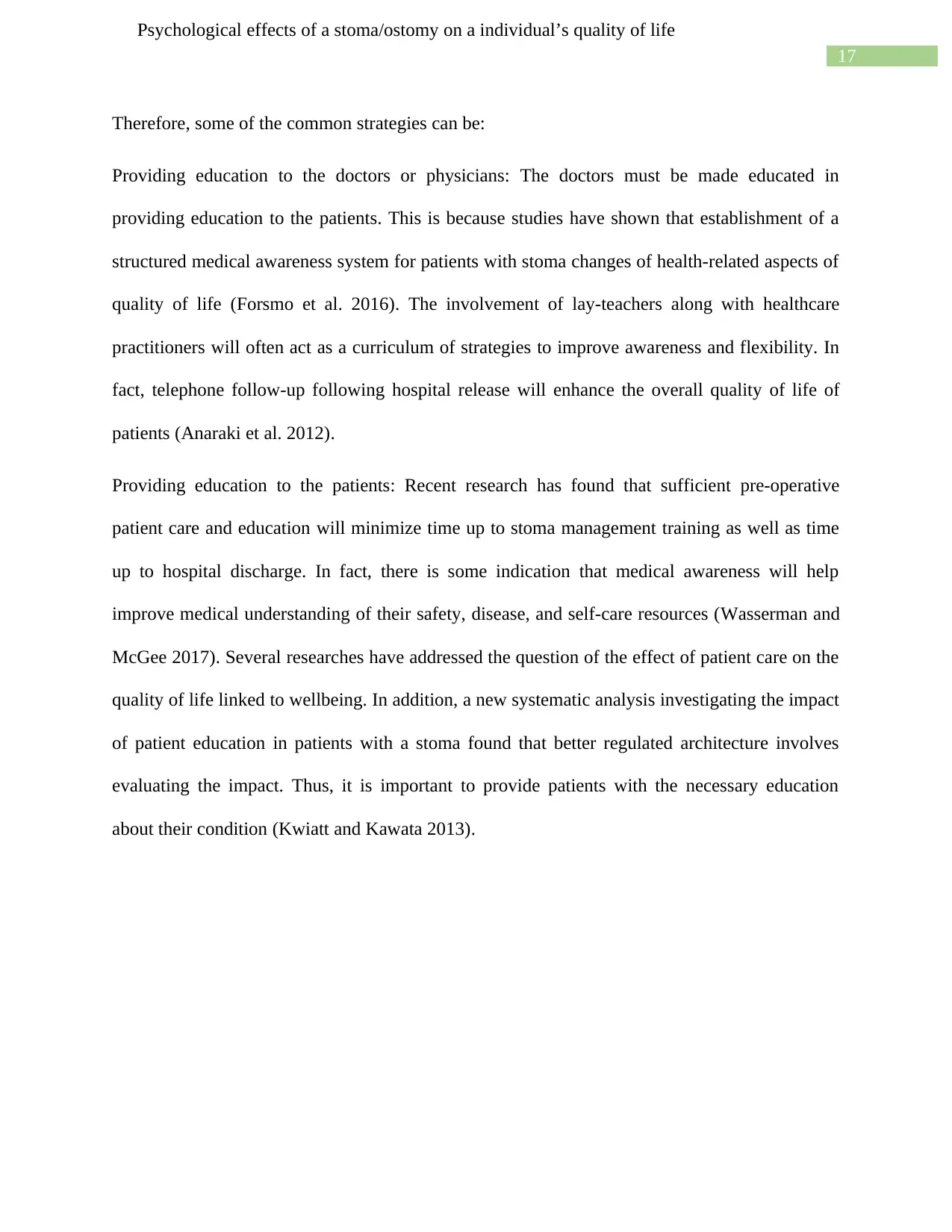
17
Psychological effects of a stoma/ostomy on a individual’s quality of life
Therefore, some of the common strategies can be:
Providing education to the doctors or physicians: The doctors must be made educated in
providing education to the patients. This is because studies have shown that establishment of a
structured medical awareness system for patients with stoma changes of health-related aspects of
quality of life (Forsmo et al. 2016). The involvement of lay-teachers along with healthcare
practitioners will often act as a curriculum of strategies to improve awareness and flexibility. In
fact, telephone follow-up following hospital release will enhance the overall quality of life of
patients (Anaraki et al. 2012).
Providing education to the patients: Recent research has found that sufficient pre-operative
patient care and education will minimize time up to stoma management training as well as time
up to hospital discharge. In fact, there is some indication that medical awareness will help
improve medical understanding of their safety, disease, and self-care resources (Wasserman and
McGee 2017). Several researches have addressed the question of the effect of patient care on the
quality of life linked to wellbeing. In addition, a new systematic analysis investigating the impact
of patient education in patients with a stoma found that better regulated architecture involves
evaluating the impact. Thus, it is important to provide patients with the necessary education
about their condition (Kwiatt and Kawata 2013).
Psychological effects of a stoma/ostomy on a individual’s quality of life
Therefore, some of the common strategies can be:
Providing education to the doctors or physicians: The doctors must be made educated in
providing education to the patients. This is because studies have shown that establishment of a
structured medical awareness system for patients with stoma changes of health-related aspects of
quality of life (Forsmo et al. 2016). The involvement of lay-teachers along with healthcare
practitioners will often act as a curriculum of strategies to improve awareness and flexibility. In
fact, telephone follow-up following hospital release will enhance the overall quality of life of
patients (Anaraki et al. 2012).
Providing education to the patients: Recent research has found that sufficient pre-operative
patient care and education will minimize time up to stoma management training as well as time
up to hospital discharge. In fact, there is some indication that medical awareness will help
improve medical understanding of their safety, disease, and self-care resources (Wasserman and
McGee 2017). Several researches have addressed the question of the effect of patient care on the
quality of life linked to wellbeing. In addition, a new systematic analysis investigating the impact
of patient education in patients with a stoma found that better regulated architecture involves
evaluating the impact. Thus, it is important to provide patients with the necessary education
about their condition (Kwiatt and Kawata 2013).
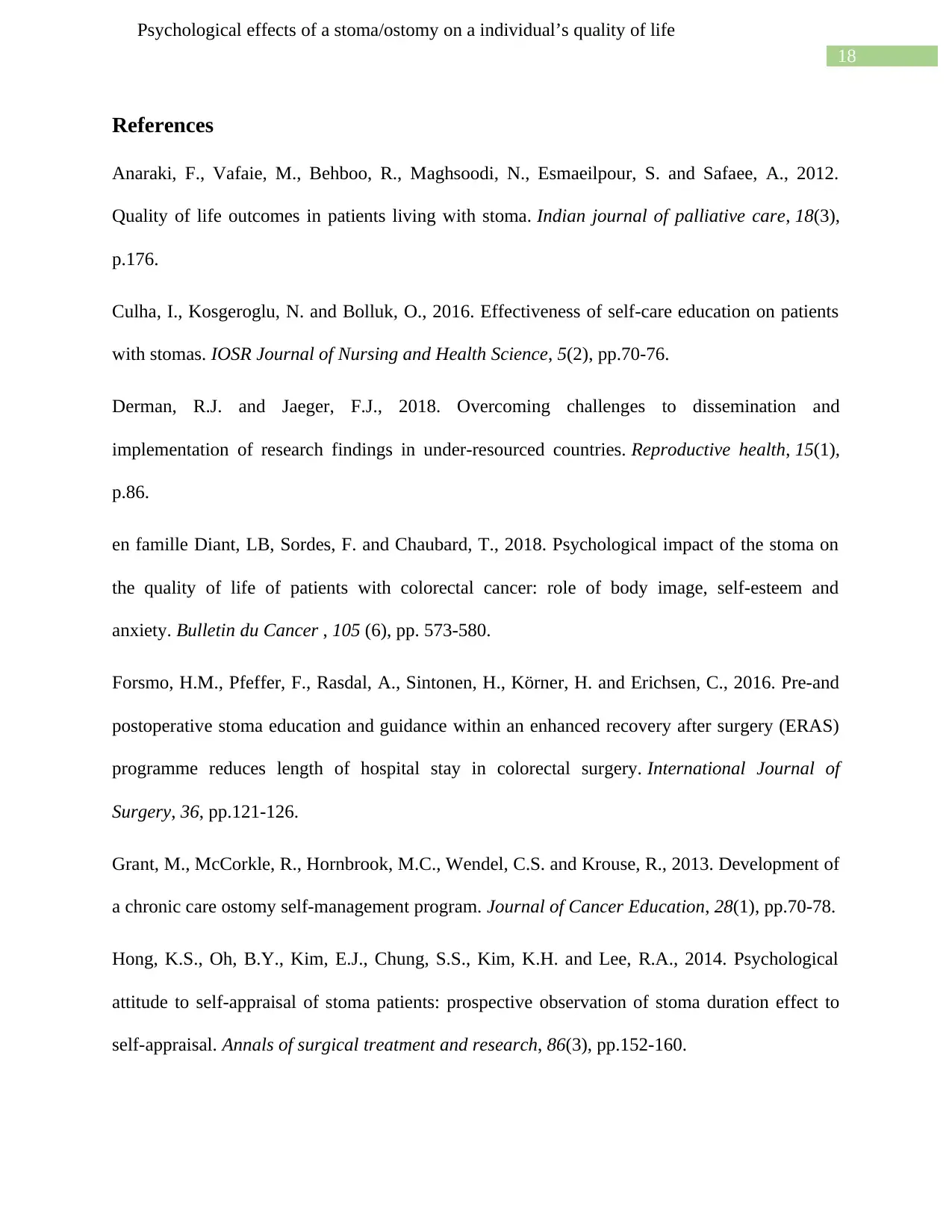
18
Psychological effects of a stoma/ostomy on a individual’s quality of life
References
Anaraki, F., Vafaie, M., Behboo, R., Maghsoodi, N., Esmaeilpour, S. and Safaee, A., 2012.
Quality of life outcomes in patients living with stoma. Indian journal of palliative care, 18(3),
p.176.
Culha, I., Kosgeroglu, N. and Bolluk, O., 2016. Effectiveness of self-care education on patients
with stomas. IOSR Journal of Nursing and Health Science, 5(2), pp.70-76.
Derman, R.J. and Jaeger, F.J., 2018. Overcoming challenges to dissemination and
implementation of research findings in under-resourced countries. Reproductive health, 15(1),
p.86.
en famille Diant, LB, Sordes, F. and Chaubard, T., 2018. Psychological impact of the stoma on
the quality of life of patients with colorectal cancer: role of body image, self-esteem and
anxiety. Bulletin du Cancer , 105 (6), pp. 573-580.
Forsmo, H.M., Pfeffer, F., Rasdal, A., Sintonen, H., Körner, H. and Erichsen, C., 2016. Pre-and
postoperative stoma education and guidance within an enhanced recovery after surgery (ERAS)
programme reduces length of hospital stay in colorectal surgery. International Journal of
Surgery, 36, pp.121-126.
Grant, M., McCorkle, R., Hornbrook, M.C., Wendel, C.S. and Krouse, R., 2013. Development of
a chronic care ostomy self-management program. Journal of Cancer Education, 28(1), pp.70-78.
Hong, K.S., Oh, B.Y., Kim, E.J., Chung, S.S., Kim, K.H. and Lee, R.A., 2014. Psychological
attitude to self-appraisal of stoma patients: prospective observation of stoma duration effect to
self-appraisal. Annals of surgical treatment and research, 86(3), pp.152-160.
Psychological effects of a stoma/ostomy on a individual’s quality of life
References
Anaraki, F., Vafaie, M., Behboo, R., Maghsoodi, N., Esmaeilpour, S. and Safaee, A., 2012.
Quality of life outcomes in patients living with stoma. Indian journal of palliative care, 18(3),
p.176.
Culha, I., Kosgeroglu, N. and Bolluk, O., 2016. Effectiveness of self-care education on patients
with stomas. IOSR Journal of Nursing and Health Science, 5(2), pp.70-76.
Derman, R.J. and Jaeger, F.J., 2018. Overcoming challenges to dissemination and
implementation of research findings in under-resourced countries. Reproductive health, 15(1),
p.86.
en famille Diant, LB, Sordes, F. and Chaubard, T., 2018. Psychological impact of the stoma on
the quality of life of patients with colorectal cancer: role of body image, self-esteem and
anxiety. Bulletin du Cancer , 105 (6), pp. 573-580.
Forsmo, H.M., Pfeffer, F., Rasdal, A., Sintonen, H., Körner, H. and Erichsen, C., 2016. Pre-and
postoperative stoma education and guidance within an enhanced recovery after surgery (ERAS)
programme reduces length of hospital stay in colorectal surgery. International Journal of
Surgery, 36, pp.121-126.
Grant, M., McCorkle, R., Hornbrook, M.C., Wendel, C.S. and Krouse, R., 2013. Development of
a chronic care ostomy self-management program. Journal of Cancer Education, 28(1), pp.70-78.
Hong, K.S., Oh, B.Y., Kim, E.J., Chung, S.S., Kim, K.H. and Lee, R.A., 2014. Psychological
attitude to self-appraisal of stoma patients: prospective observation of stoma duration effect to
self-appraisal. Annals of surgical treatment and research, 86(3), pp.152-160.
Paraphrase This Document
Need a fresh take? Get an instant paraphrase of this document with our AI Paraphraser
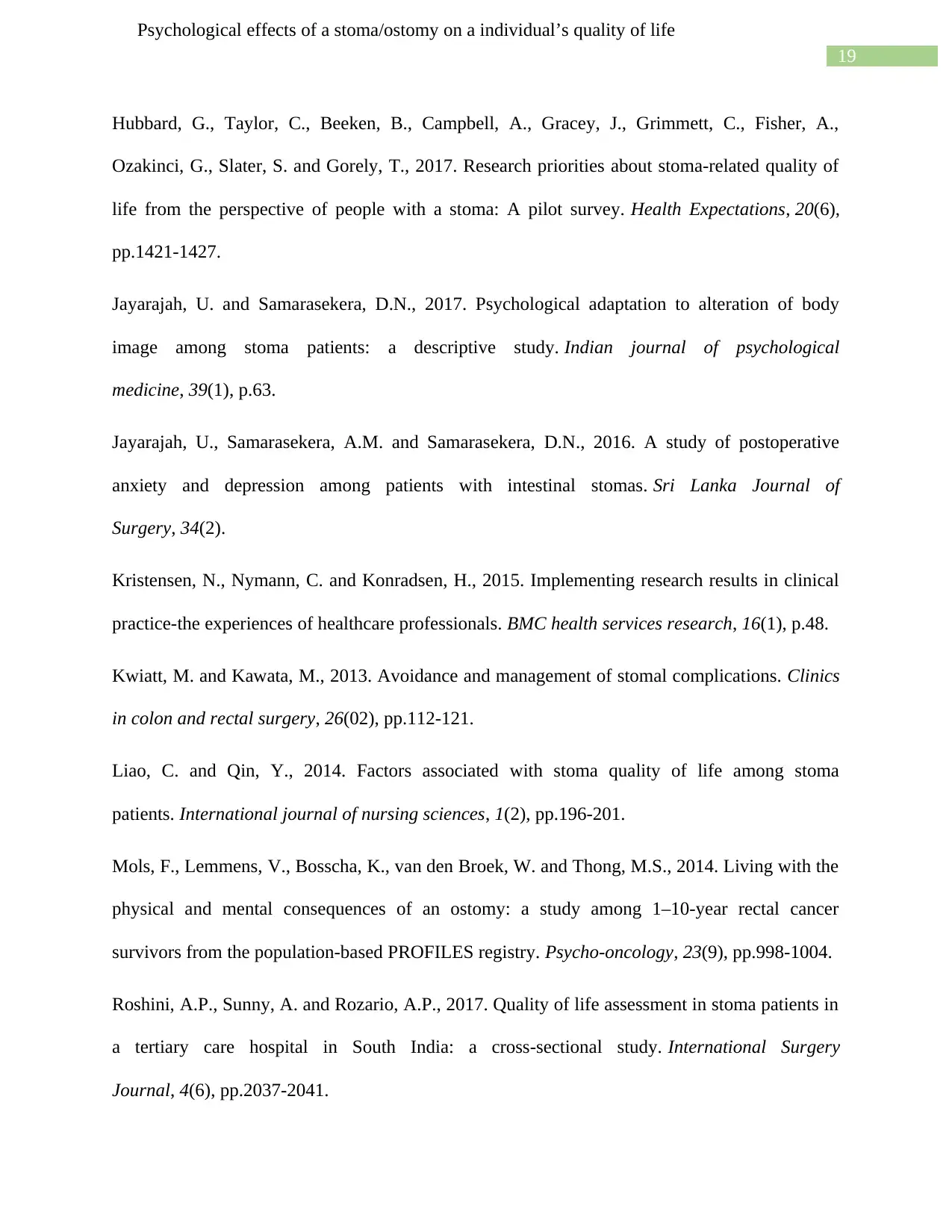
19
Psychological effects of a stoma/ostomy on a individual’s quality of life
Hubbard, G., Taylor, C., Beeken, B., Campbell, A., Gracey, J., Grimmett, C., Fisher, A.,
Ozakinci, G., Slater, S. and Gorely, T., 2017. Research priorities about stoma‐related quality of
life from the perspective of people with a stoma: A pilot survey. Health Expectations, 20(6),
pp.1421-1427.
Jayarajah, U. and Samarasekera, D.N., 2017. Psychological adaptation to alteration of body
image among stoma patients: a descriptive study. Indian journal of psychological
medicine, 39(1), p.63.
Jayarajah, U., Samarasekera, A.M. and Samarasekera, D.N., 2016. A study of postoperative
anxiety and depression among patients with intestinal stomas. Sri Lanka Journal of
Surgery, 34(2).
Kristensen, N., Nymann, C. and Konradsen, H., 2015. Implementing research results in clinical
practice-the experiences of healthcare professionals. BMC health services research, 16(1), p.48.
Kwiatt, M. and Kawata, M., 2013. Avoidance and management of stomal complications. Clinics
in colon and rectal surgery, 26(02), pp.112-121.
Liao, C. and Qin, Y., 2014. Factors associated with stoma quality of life among stoma
patients. International journal of nursing sciences, 1(2), pp.196-201.
Mols, F., Lemmens, V., Bosscha, K., van den Broek, W. and Thong, M.S., 2014. Living with the
physical and mental consequences of an ostomy: a study among 1–10‐year rectal cancer
survivors from the population‐based PROFILES registry. Psycho‐oncology, 23(9), pp.998-1004.
Roshini, A.P., Sunny, A. and Rozario, A.P., 2017. Quality of life assessment in stoma patients in
a tertiary care hospital in South India: a cross-sectional study. International Surgery
Journal, 4(6), pp.2037-2041.
Psychological effects of a stoma/ostomy on a individual’s quality of life
Hubbard, G., Taylor, C., Beeken, B., Campbell, A., Gracey, J., Grimmett, C., Fisher, A.,
Ozakinci, G., Slater, S. and Gorely, T., 2017. Research priorities about stoma‐related quality of
life from the perspective of people with a stoma: A pilot survey. Health Expectations, 20(6),
pp.1421-1427.
Jayarajah, U. and Samarasekera, D.N., 2017. Psychological adaptation to alteration of body
image among stoma patients: a descriptive study. Indian journal of psychological
medicine, 39(1), p.63.
Jayarajah, U., Samarasekera, A.M. and Samarasekera, D.N., 2016. A study of postoperative
anxiety and depression among patients with intestinal stomas. Sri Lanka Journal of
Surgery, 34(2).
Kristensen, N., Nymann, C. and Konradsen, H., 2015. Implementing research results in clinical
practice-the experiences of healthcare professionals. BMC health services research, 16(1), p.48.
Kwiatt, M. and Kawata, M., 2013. Avoidance and management of stomal complications. Clinics
in colon and rectal surgery, 26(02), pp.112-121.
Liao, C. and Qin, Y., 2014. Factors associated with stoma quality of life among stoma
patients. International journal of nursing sciences, 1(2), pp.196-201.
Mols, F., Lemmens, V., Bosscha, K., van den Broek, W. and Thong, M.S., 2014. Living with the
physical and mental consequences of an ostomy: a study among 1–10‐year rectal cancer
survivors from the population‐based PROFILES registry. Psycho‐oncology, 23(9), pp.998-1004.
Roshini, A.P., Sunny, A. and Rozario, A.P., 2017. Quality of life assessment in stoma patients in
a tertiary care hospital in South India: a cross-sectional study. International Surgery
Journal, 4(6), pp.2037-2041.
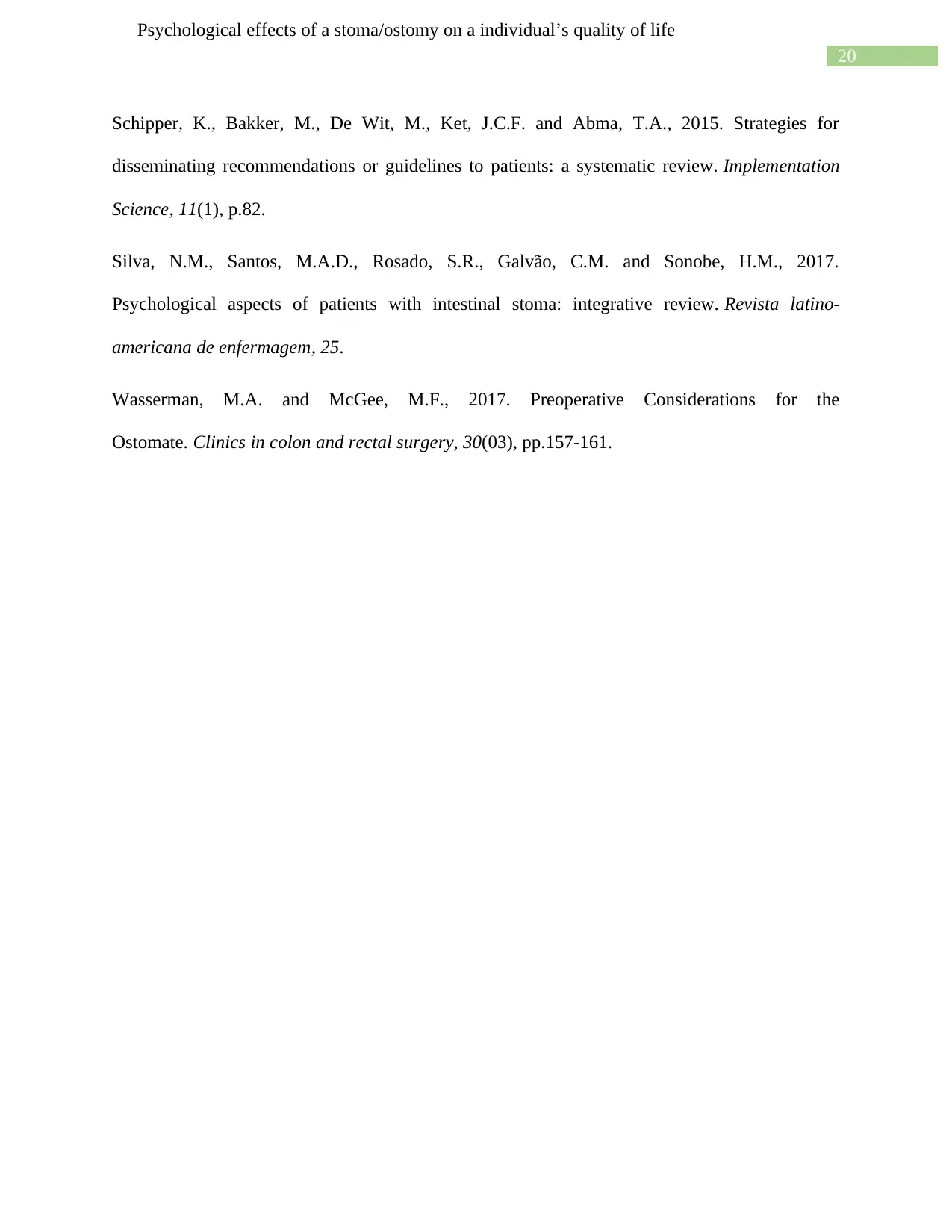
20
Psychological effects of a stoma/ostomy on a individual’s quality of life
Schipper, K., Bakker, M., De Wit, M., Ket, J.C.F. and Abma, T.A., 2015. Strategies for
disseminating recommendations or guidelines to patients: a systematic review. Implementation
Science, 11(1), p.82.
Silva, N.M., Santos, M.A.D., Rosado, S.R., Galvão, C.M. and Sonobe, H.M., 2017.
Psychological aspects of patients with intestinal stoma: integrative review. Revista latino-
americana de enfermagem, 25.
Wasserman, M.A. and McGee, M.F., 2017. Preoperative Considerations for the
Ostomate. Clinics in colon and rectal surgery, 30(03), pp.157-161.
Psychological effects of a stoma/ostomy on a individual’s quality of life
Schipper, K., Bakker, M., De Wit, M., Ket, J.C.F. and Abma, T.A., 2015. Strategies for
disseminating recommendations or guidelines to patients: a systematic review. Implementation
Science, 11(1), p.82.
Silva, N.M., Santos, M.A.D., Rosado, S.R., Galvão, C.M. and Sonobe, H.M., 2017.
Psychological aspects of patients with intestinal stoma: integrative review. Revista latino-
americana de enfermagem, 25.
Wasserman, M.A. and McGee, M.F., 2017. Preoperative Considerations for the
Ostomate. Clinics in colon and rectal surgery, 30(03), pp.157-161.
1 out of 21
Your All-in-One AI-Powered Toolkit for Academic Success.
+13062052269
info@desklib.com
Available 24*7 on WhatsApp / Email
![[object Object]](/_next/static/media/star-bottom.7253800d.svg)
Unlock your academic potential
© 2024 | Zucol Services PVT LTD | All rights reserved.

